Digital Governance in India

- 16 Jan 2025
In News:
India is making significant strides toward digital governance, an initiative aimed at enhancing both citizen services and the capabilities of government employees. This transition to a digitally-driven framework is designed to improve the efficiency, transparency, and accountability of government operations, positioning India as a global leader in modern governance practices.
What is Digital Governance?
Digital governance refers to the application of technology to enhance the functioning of government processes. By integrating digital tools and platforms, it aims to streamline administrative operations, reduce inefficiencies, and improve public service delivery. This approach also extends to ensuring greater transparency and accountability in government dealings.
Key Initiatives in Digital Governance
India has launched several critical initiatives to modernize governance through digital means. Some of the key programs include:
- iGOT Karmayogi Platform: The iGOT Karmayogi platform is a government initiative to provide online training to public employees. It aims to enhance public administration skills, foster expertise in data analytics, and equip employees with the necessary tools in digital technologies. This initiative aims to prepare government personnel to handle the challenges of a digitally evolving governance landscape.
- e-Office Initiative: The e-Office program is designed to reduce paper-based work by digitizing workflows within government departments. This initiative facilitates real-time communication among offices and ensures more efficient and transparent management of tasks. It also helps streamline decision-making processes and improves the speed of governance operations.
- Government e-Marketplace (GeM): The Government e-Marketplace (GeM) is an online platform developed to optimize procurement processes. It allows government agencies to procure goods and services efficiently, transparently, and with accountability. This platform has contributed to reducing corruption and ensuring that government purchases represent the best value for public money.
- Cybersecurity Training for Employees: As digital operations increase, ensuring the safety of sensitive data is paramount. The cybersecurity training program for government employees is designed to enhance their ability to recognize and respond to potential cyber threats. This initiative ensures data protection, safe online practices, and cyber resilience across digital governance platforms.
Challenges in Implementing Digital Governance
Despite its benefits, India faces several challenges in the successful implementation of digital governance. These obstacles must be addressed to unlock the full potential of technology-driven governance.
- Resistance to Technological Change: One of the key barriers to digital transformation in government is the resistance among employees to adopt new technologies. Many government officials remain accustomed to traditional, paper-based processes and are reluctant to transition to digital systems due to concerns about complexity and job security.
- Digital Divide in Rural Areas: While urban regions in India have better access to high-speed internet and digital infrastructure, many rural areas face significant digital divide challenges. Limited access to technology hampers the successful implementation of digital governance in these regions, restricting equitable service delivery across the country.
- Cybersecurity Risks: The rise of digital operations in governance increases the risk of cyberattacks and data breaches. With government data being digitized, the threat of cybercrimes becomes more pronounced, making it critical to implement robust cybersecurity measures and data protection strategies to safeguard sensitive information.
- Lack of Incentives for Training Outcomes: Although government employees are encouraged to take part in training programs such as iGOT Karmayogi, the absence of clear incentives to complete these programs can undermine their effectiveness. Establishing tangible rewards or career progression linked to the successful completion of training would encourage employees to fully engage in capacity-building initiatives.
Solutions to Overcome Challenges
To ensure the success of digital governance, several strategies must be put in place to address the challenges identified.
- Foster Innovation-Friendly Environments: Promoting an innovation-friendly culture within government offices can help reduce resistance to new technologies. Encouraging employees to engage with digital tools, offering regular training, and providing ongoing support will facilitate a smoother transition to a technology-driven governance system.
- Invest in Digital Infrastructure for Rural Areas: Addressing the digital divide requires significant investment in digital infrastructure in rural and remote areas. Ensuring that these regions have reliable internet access and the necessary technological resources will empower citizens across India to benefit from digital governance.
- Continuous Capacity-Building Programs: Establishing continuous training programs for government employees will ensure that they remain up-to-date with the latest technological trends. Regular updates to training content will help employees stay prepared to handle emerging challenges in digital governance.
- Strengthen Cybersecurity Protocols: To mitigate cybersecurity risks, it is essential to implement stringent cybersecurity measures across all levels of government operations. This includes regular cybersecurity awareness programs, proactive threat management systems, and rigorous data protection protocols to safeguard both government data and citizens’ personal information.
Conclusion
India’s shift towards digital governance represents a significant step toward modernizing administrative systems, enhancing transparency, and improving service delivery to citizens. However, challenges such as resistance to change, the digital divide, cybersecurity risks, and the lack of clear incentives for training must be addressed. By investing in digital infrastructure, offering continuous training programs, and reinforcing cybersecurity measures, India can create an effective and secure framework for digital governance that benefits both its citizens and the government workforce.
India’s Startup Revolution

- 15 Jan 2025
Context
India has solidified its position as one of the most dynamic startup ecosystems globally, emerging as a hub for innovation, entrepreneurship, and technological progress. However, realizing its ambition of becoming the top startup ecosystem requires addressing critical challenges and leveraging available opportunities.
Current Landscape of Indian Startups
Growth and Innovation
India ranks as the third-largest startup ecosystem in the world, following the U.S. and China. As of January 15, 2025, over 1.59 lakh startups have been officially recognized by DPIIT, with more than 120 attaining unicorn status (valuation exceeding $1 billion).
Investment Trends
Despite economic fluctuations, India's startups continue to attract significant investments. In 2022, venture capitalists infused $25 billion into the ecosystem, reaffirming India’s position as a preferred destination for global investors. Although there was a slowdown in 2023, domains like Software as a Service (SaaS) and climate tech continue to secure substantial funding.
Government Support
India’s startup-friendly policies, including Startup India, Digital India, and Atmanirbhar Bharat, have created an enabling environment. Notable initiatives include:
- Tax incentives, faster patent approvals, and regulatory relaxations.
- The launch of a ?10,000 crore Fund of Funds for Startups (FFS) in 2023 to improve capital accessibility.
- The Bharat Startup Knowledge Access Registry (BHASKAR) to streamline collaboration among startups and investors.
Regional Growth
- Tier II and III Expansion: Nearly 50% of startups are now based in emerging hubs such as Indore, Jaipur, and Ahmedabad.
- Tamil Nadu: The state boasts a $28 billion startup ecosystem, growing at 23%. Chennai alone houses around 5,000 startups, significantly contributing to employment generation.
- Kerala: With a $1.7 billion startup ecosystem, Kerala exhibits a compound annual growth rate of 254%, emphasizing cost-effective tech talent hiring.
Key Challenges Faced by Startups
1. Funding Constraints
The global economic downturn, coupled with rising interest rates, has limited venture capital inflows, resulting in layoffs and operational cutbacks.
2. Regulatory and Compliance Barriers
Despite government support, startups grapple with complex tax structures, evolving data protection laws, and stringent compliance requirements, including ESOP taxation policies.
3. Scaling and Market Adaptability
Many startups struggle with operational inefficiencies, limited market penetration, and inadequate infrastructure, hampering growth potential.
4. High Failure Rate
Approximately 90% of Indian startups fail within five years due to poor product-market fit, lack of financial planning, and insufficient adaptation to market needs.
5. Talent Shortages
India faces stiff competition in acquiring skilled professionals in areas like AI, cybersecurity, and machine learning, making retention increasingly difficult amid economic uncertainties.
Strategic Measures to Strengthen India’s Startup Ecosystem
1. Enhancing Policy Frameworks
- Simplified Regulations: Streamline startup registration, funding approvals, and international business operations.
- IP Protection: Strengthen intellectual property laws to boost R&D investment.
- Sector-Specific Initiatives: Develop targeted policies for AI, deep tech, healthcare, and green technologies.
2. Expanding Funding Access
- Encouraging Domestic Investment: Leverage pension and sovereign wealth funds to invest in startups.
- Public-Private Partnerships: Foster large-scale government-industry collaboration to finance emerging ventures.
- Decentralized Funding: Expand angel investor networks and micro-investment opportunities, particularly in Tier II and III cities.
3. Building Robust Infrastructure
- Tech Parks and Incubation Centers: Establish state-of-the-art facilities with mentorship programs.
- Improved Digital Connectivity: Ensure high-speed internet access in underserved regions.
- Enhanced Logistics and Supply Chains: Strengthen infrastructure to support startup scalability.
4. Developing a Skilled Workforce
- STEM and Entrepreneurial Education: Introduce curriculum enhancements in technical and business disciplines.
- Upskilling Programs: Collaborate with industry leaders to train professionals in high-demand skills.
- Diversity and Inclusion: Promote initiatives encouraging women and marginalized communities in entrepreneurship.
5. Fostering Innovation and Risk-Taking
- Strengthened R&D Funding: Increase allocations to universities and private research sectors.
- Encouraging Entrepreneurship: Reduce societal stigma surrounding startup failures to promote risk-taking.
- Leveraging Domestic Challenges: Address local issues like climate change and urbanization through innovation.
6. Expanding Global Reach
- International Collaborations: Partner with foreign accelerators and governments.
- Ease of Cross-Border Trade: Simplify export and import regulations for startups.
- Engaging the Indian Diaspora: Encourage successful overseas entrepreneurs to mentor and invest in Indian startups.
7. Advancing Sustainability Goals
- Green Tech Promotion: Support startups focusing on renewable energy and circular economy initiatives.
- Eco-Friendly Incentives: Offer financial support to ventures aligning with sustainability targets.
- Inclusive Growth Strategies: Expand agritech, edtech, and health-tech startups in rural areas, supporting platforms like the Women Entrepreneurship Platform (WEP) by NITI Aayog.
Building a Resilient Digital Economy
To fortify India's digital economy, startups should leverage existing infrastructure like UPI and Aadhaar while capitalizing on emerging technologies such as AI, 5G, and blockchain. A robust cybersecurity framework and data protection policies will be essential to ensure investor confidence.
Genome India Project

- 14 Jan 2025
In News:
The Genome India Project is an ambitious national initiative aimed at decoding the genetic diversity of India’s population. Launched in January 2020 by the Department of Biotechnology (DBT), the project seeks to create a comprehensive map of India’s genetic variations, offering insights that can revolutionize public health, medicine, and our understanding of human genetics.
What is Genome Sequencing?
Genome sequencing is the process of determining the complete DNA sequence of an organism’s genome. The human genome, composed of about 3 billion base pairs of DNA, contains all the genetic instructions necessary for the growth, development, and functioning of the human body. The process involves extracting DNA from a sample (often blood), breaking it into smaller fragments, and using a sequencer to decode these fragments. The data is then reassembled to reconstruct the full genome.
Key Aims and Objectives
The Genome India Project aims to address several crucial scientific and healthcare challenges:
- Create an Exhaustive Catalog of Genetic Variations: This includes common, low-frequency, rare, and structural variations (such as Single Nucleotide Polymorphisms or SNPs).
- Establish a Reference Haplotype Structure: This reference panel will be used for imputing missing genetic variations in future genetic studies.
- Design Affordable Genome-wide Arrays: These arrays will be useful for research and diagnostics at a lower cost, making genetic analysis accessible.
- Create a Biobank for Future Research: The collected DNA and plasma will be preserved for future studies to facilitate ongoing genetic research.
Genome India Project: Phase 1 and Key Findings
The project’s Phase 1 focused on sequencing the genomes of 10,074 individuals from 99 ethnic groups across India. This initiative provides a critical baseline for studying the country’s genetic diversity. Some of the key findings include:
- 459 plant species have been identified as part of genetic diversity studies.
- 135 million genetic variations have been uncovered, including 7 million that are unique to India, not found in global databases.
- The project has revealed several genetic risks specific to Indian populations, such as the MYBPC3 mutation (linked to cardiac arrest) and the LAMB3 mutation (associated with a lethal skin condition), which are not commonly seen in global datasets.
This database will serve as a vital resource for researchers, contributing to the development of precision medicine, better disease diagnosis, and more personalized treatments.
Second Phase: Expanding the Scope
The second phase of the Genome India Project will focus on sequencing the genomes of individuals suffering from specific diseases. This will enable researchers to:
- Compare the genomes of healthy individuals with those having diseases, helping identify genetic mutations responsible for conditions like cancer, diabetes, and neurodegenerative diseases.
- Investigate rare diseases specific to Indian populations and develop therapies tailored to these conditions.
By sequencing the genomes of individuals with various conditions, the project aims to pinpoint genetic factors that contribute to the pre-disposition or causation of diseases.
Data Sharing and Security
To ensure data security and privacy, the genetic information will be made available only through managed access. Researchers interested in using the data will need to submit a proposal and collaborate with the Department of Biotechnology. The data will be stored securely at the Indian Biological Data Centre (IBDC) in Faridabad, Haryana, and anonymized to maintain confidentiality.
Why Does India Need Its Own Genetic Database?
India is home to a highly diverse population, with over 4,600 distinct ethnic groups and varying genetic backgrounds. The country’s genetic diversity, shaped by its geographical, cultural, and historical context, cannot be fully understood through datasets derived from other countries. The Genome India Project helps:
- Identify Genetic Risk Factors: For various diseases, paving the way for developing targeted diagnostic tools and therapies.
- Uncover Unique Variants: Some genetic mutations found in India, such as the Vaishya community’s resistance to anaesthetics, are absent in global databases.
- Address Population-specific Health Issues: Genetic mapping enables the identification of prevalent diseases and health conditions specific to Indian populations.
Global Context and Comparison
India’s genome sequencing effort is part of a larger global movement in genomics:
- Human Genome Project (2003): The first international effort to decode the human genome.
- 1,000 Genome Project (2012): Published 1,092 human genome sequences.
- UK 100,000 Genome Project (2018): Sequenced 100,000 genomes for health research.
- European Genome Project: Aims to sequence over 1 million genomes across 24 countries.
The Genome India Project fills a crucial gap by focusing on the genetic diversity of Indian populations, which differs significantly from the genetic profiles studied in Western or European genomes.
Applications of Genome India Project
The Genome India Project has the potential to impact multiple areas:
- Advancements in Medicine: Understanding genetic variations can lead to the development of personalized medicine, where treatments are tailored to individual genetic profiles.
- Genetic and Infectious Disease Control: The project helps identify genetic resistance to diseases, and aids in understanding how certain populations may respond differently to drugs or vaccines.
- Public Health Policies: Data from the project can inform health policies, especially in tackling diseases prevalent in specific regions or communities.
- International Research Collaboration: The project aims to foster collaboration with global research communities, enhancing India’s presence in the field of genomics.
Conclusion:
The Genome India Project is a landmark initiative for India’s scientific community, enabling better understanding of the country’s genetic diversity and paving the way for breakthroughs in medicine, healthcare, and disease prevention. The ability to analyze genetic variations on such a large scale provides immense opportunities for precision medicine and personalized treatments.
Why Farmers Deserve Price Security
- 11 Jan 2025
Introduction:
The future of Indian agriculture is at a crossroads. With the shrinking of the agricultural workforce and the diversion of fertile farmlands for urbanization, ensuring the sustainability of farming is a strategic imperative. Among the various support mechanisms for farmers, the Minimum Support Price (MSP) remains a central point of debate. Should there be a legal guarantee for MSP? This question has gained prominence, especially with the rising challenges in agriculture, from unpredictable climate patterns to volatile market prices.
The Decline of Agriculture and Its Impact
India’s agricultural sector faces a dual crisis: loss of both land and human resources. Prime agricultural lands across river basins, such as the Ganga-Yamuna Doab or the Krishna-Godavari delta, are being repurposed for real estate, infrastructure, and industrial projects. Additionally, the number of "serious farmers" – those deriving at least half of their income from agriculture – is dwindling. The number of operational holdings may be 146.5 million, but only a small fraction of these farmers remains committed to agriculture.
This decline threatens the future of India’s food security, as the country will need to feed a population of 1.7 billion by the 2060s. To sustain farming and ensure long-term food security, we must secure farmers' livelihoods. Price security, particularly through MSP, plays a crucial role in this context.
The Role of MSP in Securing Farmers
MSP is the government-mandated price at which it guarantees the purchase of crops if market prices fall below a certain threshold. It provides a safety net for farmers against price volatility. The process of fixing MSP involves recommendations by the Commission for Agricultural Costs and Prices (CACP), which takes into account factors such as the cost of production and market trends. Once approved by the Cabinet Committee on Economic Affairs (CCEA), MSP is set for various crops, including rice, wheat, and sugarcane.
For farmers to stay in business, there must be a balance between production costs and returns. Farming is a risky business – yield losses can occur due to weather anomalies, pest attacks, or other natural factors. However, price risks can be mitigated with a guaranteed MSP. This would encourage farmers to invest in their land and adopt modern farming technologies, which would boost productivity and reduce costs.
Arguments for and Against Legal MSP Guarantee
Supporters of a legal MSP guarantee argue that it would provide financial security to farmers, protecting them from unpredictable market conditions. It would also promote crop diversification, encourage farmers to shift from water-intensive crops to those less dependent on irrigation, and inject resources into rural economies, thus addressing distress in rural areas.
However, critics highlight several challenges with a legal guarantee for MSP. The most significant concern is the fiscal burden it would impose on the government, potentially reaching Rs. 5 trillion. Furthermore, such a system could distort market dynamics, discouraging private traders and leading to a situation where the government becomes the primary buyer of agricultural produce. This could be economically unsustainable, especially for crops with low yields. Additionally, legal MSP guarantees could violate World Trade Organization (WTO) subsidy principles, adversely impacting India’s agricultural exports.
The Way Forward: A Balanced Approach
Given the challenges associated with a legal MSP guarantee, alternative measures should be explored. Price Deficiency Payment (PDP) schemes, such as those implemented in Madhya Pradesh and Haryana, could be expanded at the national level. These schemes compensate farmers for the difference between market prices and MSP, ensuring price security without the fiscal burden of procurement.
Additionally, the government can focus on improving agricultural infrastructure, such as cold storage facilities, to help farmers better access markets and increase price realization. Supporting Farmer Producer Organizations (FPOs) could also help farmers by enhancing collective bargaining power and ensuring better prices for their produce. Moreover, gradual expansion of MSP coverage to include a wider range of crops would encourage diversification, reducing the dominance of rice and wheat.
River Interlinking: Environmental Disaster or Solution?
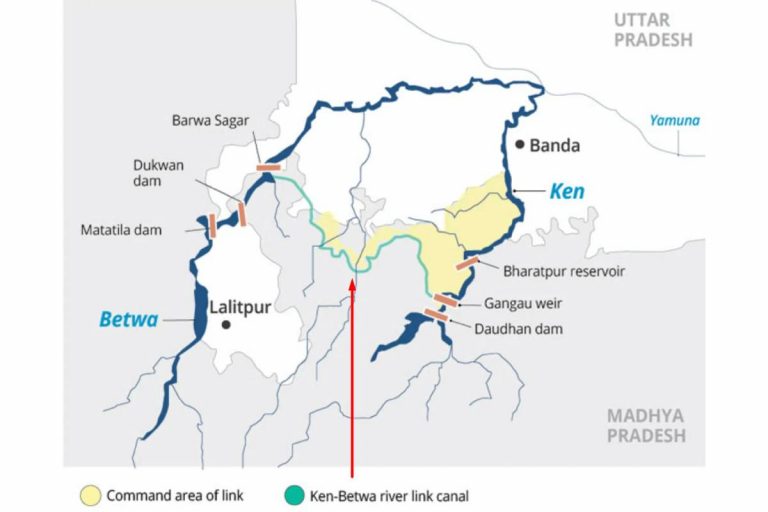
- 09 Jan 2025
Overview of the River Interlinking Concept
The concept of river interlinking in India traces its origins to the 19th century, when Sir Arthur Cotton first proposed inter-basin water transfer to address irrigation issues. Over time, this idea was refined by other experts. It evolved into the National Water Grid and, later, the River-Interlinking Project (ILR) under the Ministry of Water Resources. The goal is to transfer surplus water from rivers to drought-prone areas, aiming for water security, irrigation, and power generation.
Key Projects and Initiatives
- Ken-Betwa River Link Project (KBLP): Launched in December 2024, the KBLP will link the water-surplus Ken River with the drought-stricken Betwa River. It aims to irrigate over 10 lakh hectares, supply drinking water to 62 lakh people, and generate hydropower and solar power. However, concerns over the environmental impact of building a dam within the Panna Tiger Reserve have been raised.
- National River Linking Project (NRLP): The NRLP, formally known as the National Perspective Plan, is an ambitious proposal that includes 30 river links—14 Himalayan and 16 Peninsular—to connect India's rivers and create a giant South Asian Water Grid.
Benefits of Interlinking Rivers
- Flood and Drought Mitigation: Redistributing water from surplus areas to drought-prone regions, such as Bundelkhand, will reduce the severity of floods and droughts.
- Agriculture and Irrigation: Expanding irrigation systems across 35 million hectares of land could significantly boost agricultural productivity and food security.
- Hydropower Generation: The interlinking project has the potential to generate up to 34 GW of hydropower, contributing to India's renewable energy targets.
- Economic Growth: Improving water availability can boost industries, provide drinking water, and support economic development in underdeveloped regions.
- Inland Waterways: The project will also contribute to the expansion of inland waterways, benefiting trade and reducing transportation costs.
Challenges and Concerns
- Environmental Impact:
- Biodiversity Loss: Projects like the Ken-Betwa project raise alarms about the destruction of ecologically sensitive areas, such as the Panna Tiger Reserve.
- River Ecosystem Disruption: Altering natural river courses can harm aquatic life, disrupt deltaic ecosystems, and degrade water quality. For instance, the Sardar Sarovar Dam's impact on the Narmada river system shows the long-term consequences of such projects.
- Pollution: The mixing of cleaner and more polluted rivers could exacerbate water contamination issues.
- Social and Financial Costs:
- Displacement: Large-scale interlinking projects will displace millions, especially marginalized communities and indigenous people, and disturb local livelihoods.
- High Financial Burden: The total estimated cost of the NRLP is ?5.5 lakh crore, which does not include environmental rehabilitation costs or the long-term maintenance of the infrastructure.
- Climate Change: Predictions suggest that climate change could affect river flows and the availability of surplus water. This might render the interlinking project ineffective in the long term.
- Inter-State Conflicts: Water-sharing disputes, like the long-standing issues over the Cauvery and Krishna rivers, could intensify with more interlinking projects.
- Infrastructural Challenges: Maintaining vast canal networks and reservoirs, managing sedimentation, and acquiring land for construction are logistical hurdles.
Alternative Approaches and Solutions
- Efficient Water Management:
- Integrated Watershed Management: Implementing a comprehensive approach to manage existing water resources can reduce the need for large-scale river transfers.
- Groundwater Recharge: Focusing on efficient groundwater management by identifying recharge mechanisms and regulating water use is crucial for sustainability.
- Modern Irrigation Techniques:
- Drip Irrigation: Israel’s success with drip irrigation, which reduces water use by 25%-75%, provides an example of how modern technologies can save significant amounts of water.
- Virtual Water: Emphasizing the import of water-intensive goods (like wheat) could save local water resources, which would otherwise be used for domestic agriculture.
- National Waterways Project (NWP): An alternative to the interlinking project, NWP aims to improve water management by creating navigation channels that double as water distribution networks with a fraction of the land use.
Way Forward
- Comprehensive Impact Assessments: The need for multidisciplinary studies to evaluate the environmental, social, and economic impacts of river interlinking projects cannot be overstated. Stakeholder engagement is crucial for equitable decision-making.
- Sustainable Water Policies: A national water policy should prioritize sustainable water practices, focusing on local solutions, such as water harvesting, watershed management, and smart irrigation.
- Focus on Regional Solutions: Smaller, state-specific projects should be prioritized to address water scarcity issues without triggering large-scale environmental degradation.
The Impact of Climate Change on Earth’s Water Cycle
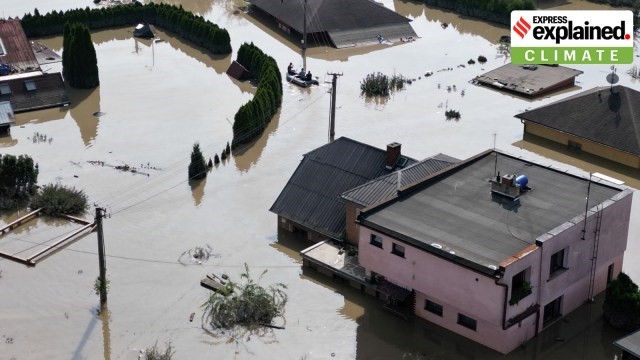
- 08 Jan 2025
In News:
Climate change is significantly affecting Earth's water cycle, leading to extreme weather events such as intense floods and prolonged droughts. According to the 2024 Global Water Monitor Report, this disruption is increasingly evident, as seen in the devastating weather patterns experienced worldwide in 2024. The report, based on data from international researchers, highlights how these changes are directly linked to rising global temperatures and the resulting shifts in precipitation patterns.
Understanding the Water Cycle
The water cycle is the continuous movement of water in various forms—solid, liquid, and gas—throughout the Earth's atmosphere, land, and bodies of water. This cycle involves processes such as:
- Evaporation: Water from the surface of oceans, lakes, and rivers turns into vapor.
- Transpiration: Water is absorbed by plants from the soil and released as vapor.
- Precipitation: Water vapor condenses into clouds and falls as rain or snow, replenishing the Earth's surface.
- Runoff and Infiltration: Precipitation either flows into rivers or infiltrates the soil, contributing to groundwater.
The water cycle is vital for maintaining the planet’s ecosystems, regulating weather patterns, and providing water for all living organisms. However, climate change is intensifying these natural processes, with far-reaching consequences.
Impact of Climate Change on the Water Cycle
As global temperatures rise, climate change is having a profound impact on the water cycle. Warmer temperatures lead to:
- Increased evaporation: As air temperatures soar, more water evaporates into the atmosphere. For every 1°C rise in temperature, the atmosphere can hold about 7% more moisture, which exacerbates storms and increases the intensity of rainfall.
- More intense precipitation: With more moisture in the atmosphere, storms have become more intense, leading to severe flooding in various regions.
- Increased droughts: Warmer air also dries out the soil. This reduces the amount of water available for crops and plants, while also increasing the evaporation rate from soil, leading to longer and more intense droughts.
This disruption of the water cycle is already causing erratic weather patterns, as some regions face severe droughts, while others are experiencing extreme rainfall and floods.
Key Findings from the 2024 Global Water Monitor Report
The 2024 report presents several alarming statistics that highlight the growing impact of climate change on the water cycle:
- Water-related disasters: In 2024, these disasters caused over 8,700 fatalities, displaced 40 million people, and resulted in economic losses exceeding $550 billion globally.
- Dry months: There were 38% more record-dry months in 2024 than the baseline period (1995-2005), underlining the growing frequency of droughts.
- Intense rainfall: Record-breaking rainfall occurred 27% more frequently in 2024 compared to 2000, with daily rainfall records set 52% more often. This shows the growing intensity of precipitation events.
- Terrestrial water storage (TWS): Many dry regions faced ongoing low TWS levels, reflecting the scarcity of water in these areas, while some regions, such as parts of Africa, saw an increase in water storage.
- Future predictions: Droughts may worsen in regions like northern South America, southern Africa, and parts of Asia, while areas like the Sahel and Europe could experience increased flood risks in the coming years.
Conclusion
The findings of the 2024 report underscore the alarming impact of climate change on the global water cycle. As temperatures continue to rise, we can expect more frequent and severe weather events, including extreme flooding and devastating droughts. These changes will affect billions of people worldwide, highlighting the urgent need for action to mitigate climate change and adapt to its consequences. Addressing this challenge requires global cooperation to reduce emissions, enhance water management systems, and protect vulnerable regions from the intensifying effects of climate change.
India-Sri Lanka Diplomatic Engagement

- 22 Dec 2024
In News:
The recent visit of Sri Lankan President Anura Kumara Dissanayake (AKD) to India marked a significant moment in bilateral relations, as it was his first foreign trip since assuming office. The visit underscored key diplomatic exchanges and collaborations between the two countries, showcasing both areas of agreement and divergence.
Key Takeaways from AKD's Visit
Assurance on Anti-India Activities: One of the primary concerns for India was the use of Sri Lankan territory for activities detrimental to its security, particularly the presence of Chinese “research vessels” at Sri Lankan ports. President AKD assured Prime Minister Narendra Modi that Sri Lanka would not allow its territory to be used in ways that threaten India’s interests. This assurance is crucial, as it signals Sri Lanka's stance on maintaining regional stability, despite AKD’s perceived pro-China inclinations.
Tamil Minority Issue: Divergent Views: A notable divergence in their discussions was the issue of the Tamil minority in Sri Lanka. India has long advocated for the full implementation of the 13th Amendment to Sri Lanka’s Constitution, which would grant greater autonomy to the Tamil minority. However, AKD resisted this, reaffirming his opposition to the amendment’s full implementation. While India emphasized the importance of reconciliation and holding provincial elections, AKD focused on unity, sustainable development, and social protection, sidestepping any definitive commitments on the Tamil issue.
Sri Lanka's Assertive Diplomatic Posture: AKD’s strong parliamentary mandate has allowed him to adopt a more assertive diplomatic stance. This is evident not only in his handling of the Tamil issue but also in his approach to dealing with major powers like India and China. His administration appears to be prioritizing a more independent foreign policy, signaling a shift from previous administrations.
Bilateral Cooperation and Development Initiatives
The visit saw significant agreements on bilateral cooperation, particularly in development and connectivity. Both nations acknowledged the positive impact of India’s assistance in Sri Lanka’s socio-economic growth. Key projects discussed include:
- Indian Housing Project: Phases III and IV.
- Hybrid Renewable Energy Projects across three islands.
- High-Impact Community Development Projects.
- Digital collaborations, such as the implementation of Aadhaar and UPI systems in Sri Lanka.
Additionally, discussions focused on enhancing energy cooperation, including the supply of LNG, development of offshore wind power in the Palk Strait, and the high-capacity power grid interconnection. The resumption of passenger ferry services between key Indian and Sri Lankan ports was also a priority.
Defence and Security Cooperation
The two leaders agreed to explore a Defence Cooperation Framework and intensify collaboration on maritime surveillance, cyber security, and counter-terrorism. This aligns with India’s strategic interests in the region, as it seeks to ensure stability in the Indian Ocean and strengthen its defense ties with Sri Lanka.
Strategic Continuity Amid Leadership Change
Despite a change in leadership, the core strategic interests between India and Sri Lanka remain aligned. India views Sri Lanka’s stability as crucial to regional security, and both countries are focused on a mutually beneficial partnership. AKD’s emphasis on economic recovery and tackling corruption within Sri Lanka, as seen in his actions against political figures like Speaker Asoka Ranwala, further signals his determination to build a strong foundation for his government’s future.
Conclusion
President AKD’s visit highlighted the evolving dynamics of Sri Lanka’s foreign policy, marked by a more confident and independent approach in engaging with India. While challenges remain, especially regarding the Tamil issue, both countries have reaffirmed their commitment to deepening bilateral ties, with a focus on development, connectivity, and strategic cooperation.
Bank Credit to Women Self-Help Groups (SHGs)

- 21 Dec 2024
Introduction
The Deendayal Antyodaya Yojana – National Rural Livelihoods Mission (DAY-NRLM) is a flagship program by the Ministry of Rural Development (MoRD) that aims to reduce poverty by empowering women, especially through Self-Help Groups (SHGs). These SHGs have been instrumental in improving financial inclusion, providing access to credit, and enhancing the economic and social status of women across India. The program has made significant strides in mobilizing women, improving their access to financial services, and facilitating entrepreneurial ventures in rural areas.
Key Features and Initiatives of DAY-NRLM
- Self-Help Groups (SHGs):
- Formation: DAY-NRLM supports the creation and strengthening of SHGs, primarily focusing on rural women from economically disadvantaged backgrounds.
- Mobilization: As of 2024, over 10.05 crore women have been mobilized into 90.87 lakh SHGs across India.
- Objective: The main goal is to reduce poverty through empowerment by providing access to financial services and sustainable livelihoods.
- Start-up Village Entrepreneurship Programme (SVEP):
- Support for Rural Enterprises: SVEP, a sub-scheme under DAY-NRLM, encourages SHG women and their families to set up small-scale businesses.
- Impact: As of October 2024, 3.13 lakh rural enterprises have been supported under this initiative.
- State-wise Distribution: The program has supported enterprises across various states, with notable contributions from Andhra Pradesh (27,651 enterprises), Kerala (34,569), and Uttar Pradesh (28,904).
- Banking Correspondent Sakhis:
- Role: Women in SHGs are trained as Banking Correspondent Sakhis to enhance access to banking services such as deposits, credit, remittances, pensions, and insurance in rural areas.
- Current Deployment: 1,35,127 Sakhis have been deployed under DAY-NRLM, empowering women to be financial intermediaries in their communities.
- Financial Support for SHGs:
- Revolving Fund: SHGs receive funds ranging from Rs. 20,000 to Rs. 30,000 to boost their operations and financial stability.
- Community Investment Fund: SHGs can avail of up to Rs. 2.50 lakh under the Community Investment Fund to strengthen their financial position.
- Interest Subvention: To make bank loans more affordable, DAY-NRLM provides interest subvention to SHGs, reducing their overall credit costs.
- Online Marketing Platform:
- www.esaras.in: This online platform allows SHGs to market their products, improving their access to broader markets and enhancing their income-generating potential.
Impact of DAY-NRLM and SHGs
- Financial Inclusion: SHGs play a vital role in financial inclusion by providing access to banking services, loans, and insurance to women, especially in rural and remote areas.
- Credit Mobilization: As of November 2024, SHGs have leveraged Rs. 9.71 lakh crore in bank credit, thanks to the capitalization support provided by DAY-NRLM, including Revolving Funds and Community Investment Funds.
- Empowerment of Women: SHGs have significantly contributed to the empowerment of women, providing them with financial independence, social support, and the ability to make decisions in their households and communities.
Challenges Faced by SHGs
- Beneficiary Identification: Ensuring that the most marginalized individuals are included in SHGs can be challenging.
- Training Gaps: There is a lack of quality training programs and expert trainers to build the capacity of SHG members.
- Financial Literacy: Many SHG members have limited knowledge of formal financial services, hindering effective financial management.
- Market Linkages: Poor integration with markets limits the growth potential of SHGs, especially in terms of product sales and business expansion.
- Community Support: Insufficient business environment support and value chain linkages pose challenges to SHG sustainability and growth.
Government Initiatives Supporting SHGs
- SHG-Bank Linkage Programme (SBLP): Launched by NABARD in 1992, this initiative aims to link SHGs with formal banking institutions, facilitating financial inclusion.
- Mission for Financial Inclusion (MFI): A broader initiative to ensure that rural populations have access to affordable financial services such as savings, credit, insurance, and pensions.
- Lakhpati Didi Initiative: Launched in 2023, this initiative empowers SHG women to adopt sustainable livelihood practices and aim for an annual household income exceeding Rs. 1 lakh.
Role of SHGs in Rural Development
- Women Empowerment: SHGs have emerged as a powerful tool for empowering women through financial independence, social security, and the ability to make informed decisions.
- Economic Growth: SHGs foster small-scale entrepreneurship, thereby creating local businesses that contribute to rural economic growth.
- Social Cohesion: By promoting collective action, SHGs provide a social support system that helps in addressing common issues faced by their members, such as health, education, and safety.
Future Prospects and Way Forward
- Technological Integration: SHGs should leverage advanced digital platforms for transaction management, record-keeping, and communication, enhancing efficiency and accessibility.
- Reducing Informal Borrowing: Linking SHGs with formal financial institutions will reduce reliance on informal lenders, promoting financial inclusion.
- Inclusive Approach: SHGs should adopt an inclusive model to ensure that members from diverse socio-economic backgrounds are fairly represented and benefit equally.
- Training and Capacity Building: There is a need for more Community Resource Persons (CRPs) who can guide SHGs in beneficiary identification, financial management, and scaling their activities.
The Costly Push for 100% Electrification of Indian Railways

- 19 Dec 2024
Introduction
RITES Ltd., the consultancy arm of the Indian Railways, has secured two contracts to repurpose six broad gauge diesel-electric locomotives for export to African railways. These locomotives, originally designed for India’s broad gauge of 1,676 mm, will be modified for use on railways with the narrower Cape Gauge of 1,067 mm. While this is a commendable re-engineering effort, it also highlights a larger issue within Indian Railways: the unnecessary redundancy of functional diesel locomotives, leading to significant wastage of resources.
The Growing Problem of Idle Diesel Locomotives
As of March 2023, there were 585 diesel locomotives idling across the Indian Railways network due to electrification. This number has now reportedly grown to 760 locomotives, many of which still have more than 15 years of serviceable life. The root cause of this redundancy lies in the government’s mission to electrify the entire broad gauge network at an accelerated pace. This electrification push has resulted in the premature retirement of locomotives that could still serve the network for years, raising questions about the economic and environmental logic behind this decision.
The Justification for Electrification: Foreign Exchange and Environmental Concerns
The Indian government’s electrification drive is often justified on two primary grounds: saving foreign exchange by reducing the import of crude oil and reducing environmental pollution. Additionally, electrification is framed as a step toward a “green railway” powered by renewable energy sources like solar and wind. However, the reality of these claims is more complicated.
Foreign Exchange Savings: A Small Impact on National Diesel Consumption
While electrification may reduce India’s diesel consumption, the impact on national fuel use is minimal. Railways account for just 2% of the country’s total diesel consumption. A report by AC Nielsen in 2014 indicated that the transport sector consumed 70% of the total diesel, with railways accounting for only 3.24%. Even with 100% electrification, the savings in foreign exchange would have little impact on the country’s overall diesel consumption, leaving other sectors like trucking and agriculture as the main contributors.
Environmental Concerns: Shifting Pollution, Not Reducing It
The environmental argument for electrification is also flawed. Electricity in India is still largely generated from coal-fired power plants, with nearly 50% of the country’s electricity coming from coal. Since the Indian Railways is heavily involved in transporting coal, switching from diesel to electric locomotives simply shifts pollution from the tracks to the power plants. This means that the transition to electric traction will not result in a cleaner environment unless the country significantly reduces its reliance on coal. Without a substantial increase in renewable energy generation, the push for a “green railway” remains unrealistic.
The Dilemma of Retaining Diesel Locomotives for Strategic Purposes
Despite the goal of 100% electrification, a significant number of diesel locomotives will remain in service. Reports indicate that 2,500 locomotives will be kept for “disaster management” and “strategic purposes,” although it is unclear why such a large fleet is necessary for these purposes. Additionally, about 1,000 locomotives will continue to operate for several more years to meet traffic commitments. This suggests that even with a fully electrified network, Indian Railways will continue to rely on thousands of diesel locomotives, many of which have substantial residual service life left.
Financial Sustainability and Coal Dependency
The financial sustainability of this transition remains a concern. Currently, the Indian Railways generates a significant portion of its freight revenue from transporting coal—40% of its total freight earnings in 2023-24. If the railways become fully electrified, it will need to find alternative revenue sources, as coal is a primary contributor. Until non-coal freight options can replace this income, the financial health of the railways may be at risk.
Conclusion: Wasted Resources and Unmet Goals
The mission to electrify the Indian Railways, while ambitious, is an example of how vanity projects can lead to colossal waste. Thousands of diesel locomotives are being discarded prematurely, despite their potential to continue serving the network. The environmental and financial justifications for 100% electrification, while appealing in theory, fail to account for the complexities of India’s energy landscape. As a result, the drive to create a “green railway” is likely to fall short, leaving behind a legacy of wasted taxpayer money and unfinished goals.
Arctic Tundra: From Carbon Sink to Carbon Source

- 18 Dec 2024
In News:
The Arctic tundra, a frozen, treeless biome, has historically been a vital carbon sink, absorbing vast amounts of carbon dioxide (CO?) and other greenhouse gases (GHGs). However, recent findings suggest that, for the first time in millennia, this ecosystem is emitting more carbon than it absorbs, a change that could have significant global consequences. This alarming shift was highlighted in the 2024 Arctic Report Card published by the National Oceanic and Atmospheric Administration (NOAA).
The Arctic Tundra’s Role as a Carbon Sink
The Arctic tundra plays a crucial role in regulating the Earth's climate. In typical ecosystems, plants absorb CO? through photosynthesis, and when they die, carbon is either consumed by decomposers or released back into the atmosphere. In contrast, the tundra’s cold environment significantly slows the decomposition process, trapping organic carbon in permafrost—the permanently frozen ground that underpins much of the region.
Over thousands of years, this accumulation of organic matter has resulted in the Arctic storing an estimated 1.6 trillion metric tonnes of carbon. This figure is roughly double the amount of carbon in the entire atmosphere. As such, the tundra has served as a critical carbon sink, helping to mitigate global warming by trapping vast quantities of CO?.
Shifting Dynamics: Emission of Greenhouse Gases
Recent reports indicate a dramatic shift in the Arctic tundra’s role in the carbon cycle. Rising temperatures and increasing wildfire activity have disrupted the tundra’s balance, leading it to transition from a carbon sink to a carbon source.
Impact of Rising Temperatures
The Arctic region is warming at a rate approximately four times faster than the global average. In 2024, Arctic surface air temperatures were recorded as the second-warmest on record since 1900. This rapid warming is causing permafrost to thaw, which in turn activates microbes that break down trapped organic material. As this decomposition accelerates, carbon in the form of CO? and methane (CH?)—a more potent greenhouse gas—are released into the atmosphere.
The experts, explained the process by comparing thawing permafrost to meat left out of the freezer. Similarly, thawing permafrost accelerates the breakdown of trapped carbon.
The Role of Wildfires
In addition to warming temperatures, the Arctic has experienced a surge in wildfires in recent years. 2024 marked the second-highest wildfire season on record in the region, releasing significant amounts of GHGs into the atmosphere. Wildfires exacerbate the thawing of permafrost, creating a feedback loop where increased carbon emissions contribute further to warming, which, in turn, leads to more emissions.
Between 2001 and 2020, these combined factors caused the Arctic tundra to release more carbon than it absorbed, likely for the first time in millennia.
The Global Consequences of Emission
The transition of the Arctic tundra from a carbon sink to a carbon source is alarming, as it represents a significant amplification of global climate change. The release of additional CO? and CH? into the atmosphere further accelerates the greenhouse effect, leading to higher global temperatures. This warming is already having visible consequences around the world, from extreme weather events to rising sea levels.
If the Arctic tundra continues to emit more carbon than it absorbs, it could significantly exacerbate the climate crisis. The report underscores the urgency of addressing global emissions, as reducing greenhouse gases remains the most effective way to prevent further destabilization of this sensitive ecosystem.
Mitigating the Impact: The Path Forward
Despite the alarming trends, the Arctic Report Card suggests that it is still possible to reverse this process. By reducing global GHG emissions, it may be possible to slow the thawing of permafrost and allow the Arctic tundra to regain its role as a carbon sink. Scientists emphasize that mitigating climate change on a global scale is essential to prevent further emissions from the Arctic ecosystem.
Scientists, stressed the importance of emission reductions, stating, “With lower levels of climate change, you get lower levels of emissions from permafrost… That should motivate us all to work towards more aggressive emissions reductions.”
However, current trends suggest that achieving this goal may be challenging. A recent report from the Global Carbon Project indicates that fossil fuel emissions are likely to rise in 2024, with total CO? emissions projected to reach 41.6 billion tonnes, up from 40.6 billion tonnes in 2023.
Artificial Solar Eclipse: Why Are Satellites Trying to Block the Sun?
- 14 Dec 2024
Introduction
The European Space Agency (ESA) has launched Proba-3, a mission that will create an artificial solar eclipse to study the Sun's atmosphere, known as the corona. This mission aims to demonstrate new technology and address unresolved questions about the Sun's outer layers.
What is an Artificial Solar Eclipse?
- Definition: An artificial solar eclipse mimics the natural phenomenon where the moon blocks sunlight, allowing detailed observation of the Sun’s corona.
- Created By: The eclipse is created by two satellites, which align to block the Sun's light and generate a controlled shadow for scientific study.
- Purpose: The goal is to study the Sun’s corona, particularly to understand why it is significantly hotter than the Sun’s surface.
How Does the Proba-3 Create an Eclipse?
Launch and Spacecraft
Proba-3 was launched on December 5 from the Satish Dhawan Space Centre in India. The mission uses two satellites:
- Coronagraph Spacecraft (CSC): This spacecraft guides the other satellite.
- Occulter Spacecraft (OSC): This satellite has a disk that creates a controlled shadow onto the CSC.
Formation Flying
Using Precise Formation Flying (PFF) technology, the two spacecraft maintain a precise distance of 150 meters (492 feet) apart, aligning perfectly with the Sun. This alignment mimics the effect of a solar eclipse.
Precision Requirements
The eclipse will need to maintain millimetre-level accuracy for up to six hours per orbit to provide scientists with stable observational conditions.
Mission Goals
- Demonstrating PFF Technology: One of the primary objectives of the Proba-3 mission is to demonstrate PFF technology. This involves using GPS and inter-satellite radio links for positioning, as well as maintaining a precise distance between the two spacecraft.
- Studying the Sun’s Corona: Another goal is to understand why the corona is hotter than the Sun's surface. The onboard instruments, including a coronagraph, will help with this research. The coronagraph will block out the Sun’s bright light, enabling clearer observations of the corona.
- ASPICCS Coronagraph: The Proba-3 coronagraph, named the Association of Spacecraft for Polarimetric and Imaging Investigation of the Corona of the Sun (ASPICCS), is designed to observe the corona in high detail, mimicking the observational conditions of a total solar eclipse.
Why Is This Such a Big Deal?
- Revealing the Sun’s Corona: The Sun’s corona is typically invisible because it is much less bright than the Sun’s surface. It can only be seen during a solar eclipse when the Moon blocks the Sun's light.
- Predicting Space Weather: Studying the corona helps scientists predict space weather and geomagnetic storms, which can disrupt satellites and other systems on Earth.
- Extended Observations: Unlike natural solar eclipses, which last only a few minutes, Proba-3 can provide six hours of observation time in each orbit (approximately 19 hours and 36 minutes), allowing for continuous study of the corona.
What is Precise Formation Flying (PFF) Technology?
- Definition: PFF technology allows satellites to maintain exact positions and orientations relative to each other in orbit.
- Mechanism: The technology uses GPS, inter-satellite radio links, and automated control systems to ensure alignment.
- Implementation in Proba-3: In the Proba-3 mission, the Coronagraph and Occulter spacecraft stay 150 meters apart, using PFF to maintain millimetre-level precision, which is crucial for simulating a solar eclipse.
- Benefits: PFF enhances mission accuracy and provides a platform for advanced observational techniques that will enable more detailed studies of the Sun's corona.
Conclusion
Proba-3 is a groundbreaking mission that will offer unprecedented insights into the Sun’s corona by simulating solar eclipses using advanced satellite technology. By studying the Sun’s outer layers, scientists aim to improve our understanding of space weather and the mysterious temperature anomaly of the corona.
Impeachment of Judges
- 12 Dec 2024
In News:
The recent controversy surrounding remarks made by Justice Shekhar Kumar Yadav of the Allahabad High Court has prompted calls for his impeachment. During an event organized by the Vishwa Hindu Parishad (VHP), Justice Yadav made statements that were perceived as communal, leading to concerns over judicial impartiality. This incident has reignited discussions about the impeachment process for judges in India, highlighting the delicate balance between judicial independence and accountability.
Impeachment Process for Judges in India
In India, the impeachment process for judges, although not explicitly mentioned in the Constitution, serves as a mechanism to ensure judicial accountability while safeguarding judicial independence. The process is outlined under Articles 124 and 218 of the Indian Constitution, which govern the removal of Supreme Court and High Court judges, respectively.
Grounds for Impeachment
Judges in India can be removed on two grounds:
- Proved Misbehavior: Conduct that breaches the ethical standards of the judiciary.
- Incapacity: A judge’s inability to perform judicial duties due to physical or mental infirmity.
These grounds are clearly specified to prevent arbitrary removal, ensuring that the process remains fair and just.
Steps in the Impeachment Process
- Initiation of Motion: The process begins when a motion for impeachment is introduced in Parliament, either in the Lok Sabha or Rajya Sabha. The motion must be supported by at least 100 members of the Lok Sabha or 50 members of the Rajya Sabha. This ensures significant parliamentary backing before the motion proceeds.
- Formation of an Inquiry Committee: If the motion is admitted, a three-member inquiry committee is constituted. This includes a Supreme Court judge, the Chief Justice of a High Court, and a distinguished jurist. The committee conducts a thorough investigation into the allegations.
- Committee Report and Parliamentary Debate: Following the investigation, the committee submits its findings. If the judge is found guilty, the report is debated in Parliament. Both Houses must approve the motion by a special majority, which requires a two-thirds majority of members present and voting, as well as a majority of the total membership.
- Final Removal by the President: Once the motion is passed in both Houses, it is presented to the President, who issues the removal order.
Safeguards Against Misuse
The impeachment process includes several safeguards to prevent misuse:
- High Threshold for Initiation: The requirement for significant support from Parliament ensures that the process cannot be initiated frivolously.
- Objective Inquiry: The inquiry committee, comprising legal experts, guarantees an impartial investigation.
- Parliamentary Scrutiny: Both Houses of Parliament are involved, ensuring that the process undergoes democratic scrutiny.
Challenges and Precedents
Despite the rigorous process, no Supreme Court judge has been successfully impeached to date. Past attempts, such as those against Justice V. Ramaswami (1993) and Chief Justice Dipak Misra (2018), were unsuccessful. These instances demonstrate the complexities involved in the impeachment process.
Guidelines for Judges’ Public Statements
Judges in India are entitled to freedom of speech, but they are expected to exercise caution in public statements to maintain the dignity of their office. The Bangalore Principles of Judicial Conduct (2002) and the Restatement of Values of Judicial Life (1997) outline key principles for judicial conduct, including:
- Non-Interference in Political Matters: Judges should refrain from commenting on political issues to avoid any perception of bias.
- Impartiality: Judges must avoid statements that could prejudice ongoing cases or align them with specific ideologies.
Upholding Judicial Impartiality in a Diverse Society
To maintain impartiality, judges must interpret laws based on constitutional values of justice, equality, and secularism. Furthermore, the judiciary must ensure representation from diverse backgrounds to foster inclusivity and reduce systemic biases. Training programs focused on cultural competence and social diversity are essential to ensure that judges are sensitive to the needs of marginalized communities.
Conclusion
The impeachment process, while stringent, plays a critical role in maintaining judicial accountability in India. As seen in the case of Justice Yadav, judicial conduct, particularly public statements, must be carefully scrutinized to preserve the integrity of the judiciary. Upholding impartiality and adhering to constitutional values are paramount in ensuring that the judiciary continues to function as a neutral arbiter in India’s democracy.
Analysis of Female Labour Force Participation Rate (LFPR) Trends in India: 2017-2023
- 11 Dec 2024
In News:
The Economic Advisory Council to the Prime Minister (EAC-PM) recently released a working paper revealing critical insights into the trends of female Labour Force Participation Rate (LFPR) in India from 2017-18 to 2022-23. The report highlights an overall increase in female LFPR, with rural areas experiencing more significant growth compared to urban areas. This article delves into the key findings, regional disparities, influencing factors, and government initiatives aimed at promoting female workforce participation.
Key Findings on Female LFPR
The period between 2017-18 and 2022-23 witnessed a notable rise in female LFPR, both in rural and urban regions, though rural areas saw higher gains.
Rural female LFPR surged by approximately 69%, from 24.6% to 41.5%, while urban female LFPR increased from 20.4% to 25.4%. This consistent growth was observed even after excluding unpaid family workers or household helpers, reinforcing the long-term trend of increased female workforce participation across India.
However, a significant point of discussion in the report was the regional variations in female LFPR. States like Bihar, Punjab, and Haryana have consistently reported low female LFPR, which is noteworthy considering that Punjab and Haryana are among India's wealthiest states, while Bihar is the poorest. This regional disparity suggests that economic prosperity does not automatically translate into higher female labour force participation, highlighting deeper socio-cultural and structural barriers.
Regional Disparities in Female LFPR
The report emphasizes the persistent challenges in northern and eastern India. Punjab and Haryana, despite their affluence, have struggled with low female LFPR. Cultural and societal norms in these regions may contribute to the underrepresentation of women in the workforce, particularly in rural areas where traditional gender roles are more entrenched.
On the other hand, Bihar, the poorest state in India, had the lowest female LFPR in the country, particularly in rural areas. However, there has been a significant improvement in recent years, especially among rural married women. This indicates a slow but positive shift in attitudes towards female employment in these states.
In contrast, northeastern states such as Nagaland and Arunachal Pradesh have shown significant improvements in female LFPR, particularly in rural areas. These states have demonstrated that regional and cultural factors can also create conducive environments for female workforce participation.
Demographic Factors Affecting Female LFPR
Several demographic patterns influence female LFPR, including marital status and age. The report notes that married men consistently exhibit higher LFPR compared to women. Marriage, however, has a detrimental impact on female LFPR, particularly in urban areas, where women often face greater familial and societal pressures to prioritize domestic responsibilities over formal employment.
Age dynamics also play a crucial role in female LFPR trends. The data reveals a bell-shaped curve for female participation, peaking around the age of 30-40 years and sharply declining thereafter. This is in stark contrast to male LFPR, which remains almost universally high between the ages of 30-50 before gradually declining. These trends underscore the challenges women face in sustaining their participation in the workforce due to familial responsibilities, especially after marriage and childbirth.
Government Initiatives and the Rise in Female LFPR
The government's focus on women-led development is evident through various schemes aimed at increasing female workforce participation. Programs like Mudra Loans, the Drone Didi Scheme, and the Deendayal Antyodaya Yojana have been particularly instrumental in empowering women, especially in rural areas. These initiatives provide women with access to financial resources, skill development opportunities, and avenues for entrepreneurship, all of which contribute to the rise in female LFPR.
The EAC-PM's analysis acknowledges the positive impact of these government schemes, but it also stresses the need for further research to evaluate their long-term effectiveness. While the descriptive analysis highlights a substantial increase in female LFPR between 2017-18 and 2022-23, especially in rural areas, there remains a need for continuous monitoring and assessment of these schemes to ensure their sustained impact.
Conclusion: A Positive Shift, but Challenges Remain
The increase in female LFPR across India from 2017-18 to 2022-23 signals a positive shift in employment trends, particularly in rural areas. However, regional disparities, societal norms, and demographic factors continue to pose challenges. The rise in female LFPR is encouraging, but it is essential to understand the deeper socio-economic factors that shape women's participation in the workforce.
Government schemes have contributed to this growth, but future research is necessary to gauge their long-term effects and ensure that women’s participation in the workforce is not just a short-term trend. It is crucial that the government continues to refine policies that support women in overcoming socio-cultural and economic barriers, especially in less prosperous states like Bihar, Punjab, and Haryana. Sustained efforts, including education, skill development, and gender-sensitive policies, will be key to ensuring that the rise in female LFPR is both inclusive and long-lasting.
The analysis by the EAC-PM provides an essential framework for policymakers to design more targeted interventions to address regional disparities and create a more inclusive labor market for women in India.
No-Confidence Motion Against Rajya Sabha Chairman
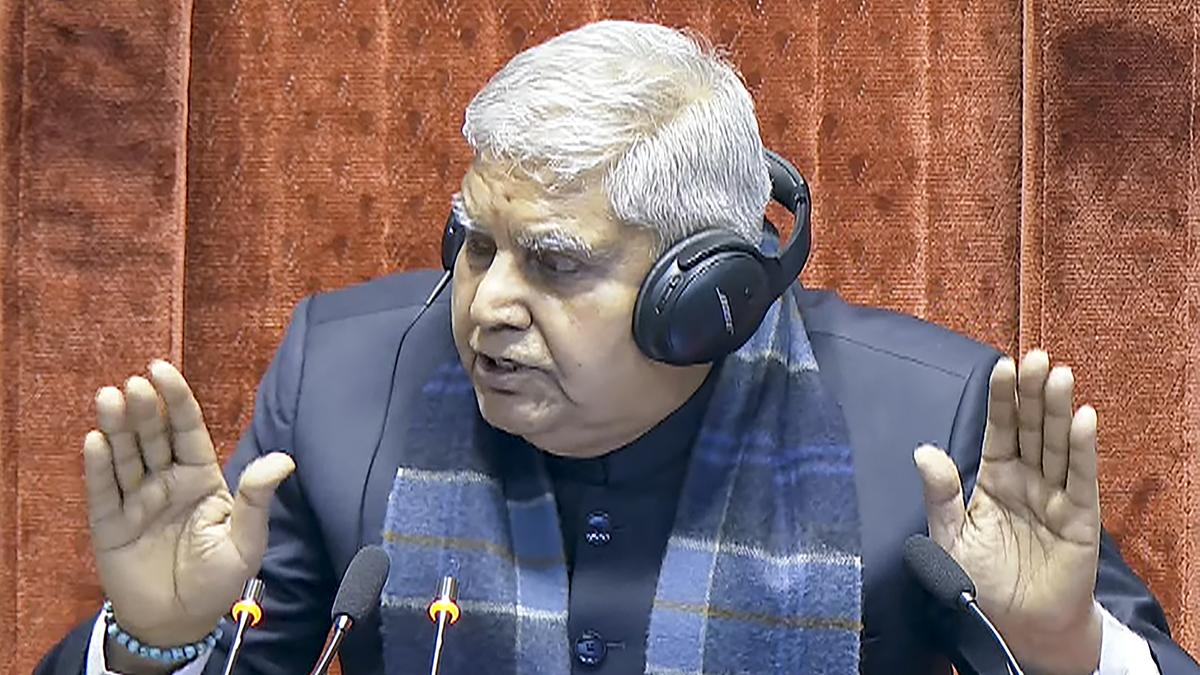
- 10 Dec 2024
In News:
In December 2024, around 60 opposition MPs from the INDIA (Indian National Developmental, Inclusive Alliance) bloc submitted a notice to the Rajya Sabha Secretariat, seeking the removal of Vice President Jagdeep Dhankhar from his position as the Chairman of the Rajya Sabha. This unprecedented move has sparked significant political debate, with the opposition accusing Dhankhar of partisanship and bias in the conduct of parliamentary proceedings.
The Charges Against Jagdeep Dhankhar
Allegations of Bias and Partisanship
The opposition has raised several allegations against Dhankhar since his appointment as the Rajya Sabha Chairman in August 2022. These include:
- Partiality towards the ruling government: The opposition claims that Dhankhar has shown bias in favor of the BJP, with accusations of repeatedly denying the Leader of the Opposition, Mallikarjun Kharge, the opportunity to respond to statements made by Prime Minister Narendra Modi and BJP President J.P. Nadda.
- Interference in Parliamentary Debates: Opposition MPs have accused Dhankhar of disrupting their speeches and allowing ruling party members to dominate parliamentary discussions.
- Unbecoming Remarks: The notice also refers to comments made by Dhankhar, including praising the Rashtriya Swayamsevak Sangh (RSS) and recalling his association with "so-called cultural organizations." These actions, according to the opposition, violate the non-partisan nature expected of the Chairman.
The Constitutional Framework for Removal of the Vice-President
Legal Provisions for Impeachment
The Vice-President of India, who also serves as the Chairman of the Rajya Sabha, is elected for a five-year term. Article 67 of the Indian Constitution outlines the procedure for his removal:
- Notice Requirement: A motion for the removal of the Vice-President must be introduced in the Rajya Sabha with a prior 14-day notice.
- Approval Process: The resolution must be passed by a majority in the Rajya Sabha and then approved by the Lok Sabha.
- Grounds for Removal: The Vice-President can only be removed through a resolution that is supported by a majority in both Houses of Parliament.
Opposition’s Plan and Challenges
Despite lacking the necessary numbers in the Rajya Sabha to succeed in the impeachment motion, the opposition's move is aimed at sending a political message to the BJP, expressing dissatisfaction with the functioning of the Parliament under Dhankhar’s leadership.
The current session of Parliament is scheduled to end on December 20, 2024, leaving little time for the motion to gain traction. The opposition also does not have the numbers needed for a majority in the Rajya Sabha, which complicates the chances of success for the motion.
Historical Precedents for Similar Resolutions
The last notable attempt to remove a parliamentary officer occurred in 2020 when the opposition moved a no-confidence motion against Rajya Sabha Deputy Chairman Harivansh. This motion was prompted by his decision to extend the session during the contentious farm Bills debate. Although the motion was discussed, it did not result in any significant change.
Similarly, there have been instances where motions to remove Lok Sabha Speakers have been moved but not passed, such as against G.V. Mavalankar in 1951, Sardar Hukam Singh in 1966, and Balram Jakhar in 1987.
Role and Significance of the Vice-President in India
Constitutional Role
The Vice-President of India holds the second-highest constitutional office, primarily functioning as the ex-officio Chairman of the Rajya Sabha. His duties include:
- Presiding over Rajya Sabha Sessions: The Vice-President ensures the smooth functioning of the Rajya Sabha and maintains order during debates. He does not typically vote except in the case of a tie.
- Acting President: In the absence, resignation, or death of the President, the Vice-President assumes the role of the Acting President.
Removal Process Under Article 67
- Article 67(b) of the Constitution specifies the process for the removal of the Vice-President, requiring a 14-day notice and approval from both Houses of Parliament. This provision ensures that any such resolution receives due consideration and is not moved hastily.
Implications for Parliamentary Democracy
- Risks to Parliamentary Integrity: Opposition leaders have expressed concern that the current political environment is eroding the integrity of India’s parliamentary system. They argue that by misusing constitutional offices for partisan ends, the ruling government risks undermining the democratic foundations of the country.
Significance of the Move
- Although the opposition may not succeed in removing Dhankhar, the notice serves as a powerful symbol of resistance. The move underscores the opposition’s commitment to defending the principles of parliamentary democracy and the need for impartiality in the conduct of parliamentary affairs.
Conclusion
The opposition’s push to remove Vice-President Jagdeep Dhankhar from his position as the Chairman of the Rajya Sabha highlights the growing political tensions in India’s Parliament. While the move may not succeed due to the lack of numerical support, it brings to the forefront critical issues regarding the independence of constitutional offices and the functioning of parliamentary democracy in India. The developments around this notice will continue to be a significant point of discussion as the winter session of Parliament draws to a close.
Scrapping of Windfall Gains Tax

- 05 Dec 2024
Introduction
On December 2, 2024, the Indian government withdrew the windfall gains tax on domestic crude oil production and fuel exports (diesel, petrol, and aviation turbine fuel - ATF). This tax, initially imposed in July 2022, was introduced in response to the surge in global oil prices following Russia's invasion of Ukraine. Its removal reflects the current global oil market stability and the improved fuel supply situation in India.
What is Windfall Gains Tax?
Definition
A windfall tax is a levy imposed on unexpected profits that result from extraordinary events, such as geopolitical crises or market disruptions. In the case of India, the tax was applied to the super-normal profits of oil producers and fuel exporters due to the global energy turmoil.
Key Features
- Domestic Crude Oil: The Special Additional Excise Duty (SAED) was imposed on domestic crude oil production.
- Fuel Exports: A combination of SAED and Road and Infrastructure Cess (RIC) was levied on diesel, petrol, and ATF exports.
Rationale Behind the Windfall Gains Tax
Immediate Context
The tax was introduced during a period of soaring global crude oil prices, driven by the Russia-Ukraine conflict. India, which imports over 85% of its oil, faced concerns about the availability of fuels and the impact of rising prices on domestic consumption. The tax was seen as a way to:
- Ensure Domestic Fuel Supply: By discouraging excessive fuel exports during a period of global supply chain disruptions.
- Increase Government Revenue: The tax aimed to capture windfall profits and offset the duty cuts on domestic fuel sales.
Global Context
Other countries also implemented similar windfall taxes during this period, as energy companies saw record profits due to the price surge.
Decline in Windfall Gains Tax Revenue
Revenue Collection
The windfall gains tax initially raised significant revenue, but the amount has decreased over time due to falling global oil prices:
- FY 2022-23: Rs 25,000 crore
- FY 2023-24: Rs 13,000 crore
- FY 2024-25 (so far): Rs 6,000 crore
This decline, combined with reduced oil prices, led to the tax being effectively inactive before its formal withdrawal.
Withdrawal of the Windfall Gains Tax
Reasons for the Withdrawal
- Global Stabilization: Crude oil prices, which had exceeded $100 per barrel, have now stabilized under $75 per barrel, with no immediate signs of a significant price surge.
- Domestic Fuel Availability: There is now a robust fuel supply in the domestic market, making the tax less necessary.
- Declining Revenues: With the tax generating diminishing returns, it was no longer economically viable for the government to maintain it.
Impact of the Scrapping
The government's move to scrap the windfall gains tax is seen as a signal of stability and predictability in the taxation regime. It assures the oil industry that the government is confident in the stability of global oil prices and supply chains.
Criticism of the Windfall Tax
Industry Opposition
The windfall tax faced opposition from the oil industry, which argued that it:
- Reduced Profitability: The tax limited the profits of publicly listed companies like ONGC and Reliance Industries.
- Discouraged Oil Production: By making the taxation environment unpredictable, it deterred investment in oil exploration and production in a country that is heavily dependent on oil imports.
- Created Uncertainty: Frequent revisions of the tax led to an unstable business environment.
Conclusion
The scrapping of the windfall gains tax is a significant policy shift. It not only provides relief to oil companies but also signals a more predictable and stable taxation regime. By withdrawing the tax, the government is fostering a conducive environment for future investments in domestic oil production and signaling its confidence in the stability of global oil prices. This move is a crucial step in ensuring that India’s energy policies remain adaptable and aligned with the evolving global market conditions.
Current Representation of Women in CAPFs

- 04 Dec 2024
In News:
The Central Armed Police Forces (CAPFs) of India, comprising forces like CRPF, BSF, CISF, and others, play a crucial role in maintaining internal security. Women’s participation in these forces has been historically limited, but recent efforts have focused on increasing their representation. As of 2024, women constitute only 4.4% of the total personnel in CAPFs, highlighting the slow progress despite various initiatives.
Current Representation and Changes Over Time
- Overall Representation: Women make up 4.4% of the 9.48 lakh-strong CAPFs. Within this, the Central Industrial Security Force (CISF) has the highest representation at 7.02%, followed by the Sashastra Seema Bal (SSB) at 4.43%, Border Security Force (BSF) at 4.41%, Indo-Tibetan Border Police (ITBP) at 4.05%, Assam Rifles at 4.01%, and Central Reserve Police Force (CRPF) at 3.38%.
- Growth of Women Personnel: From 15,499 women in 2014, the number has tripled to 42,190 in 2024, reflecting a steady increase in recruitment. However, the percentage remains low despite these gains.
- Recruitment Trends: In 2024, 835 women were recruited, with 5,469 more in the process. In 2025, 4,138 women are expected to be recruited.
Government Efforts and Parliamentary Committee Recommendations
- Policy Measures: The government has introduced several steps to encourage women’s participation in CAPFs, such as reservations in constable-level positions: one-third for CRPF and CISF, and 14-15% for border forces like BSF, SSB, and ITBP.
- Challenges in Recruitment: Despite these policies, recruitment has not kept pace with the targets. The 2022 Parliamentary Committee on Home Affairs expressed disappointment over the “abysmally low” number of women in CAPFs, noting that women made up only 3.68% of the forces at that time.
- Recommendations by Parliamentary Committees:
- The Home Affairs Committee recommended fast-tracking phase-wise recruitment of women, particularly in CISF and CRPF.
- The Standing Committee on Personnel (2023) suggested “soft postings” for women to avoid difficult working conditions, especially in remote or strenuous terrains. It also called for reservations for transgender individuals.
- In 2024, further steps like fee waivers, relaxed physical standards, and provisions for maternity and child care leave were introduced to make the work environment more inclusive.
Reasons Behind Low Representation
- Cultural Barriers: Traditional gender roles and societal expectations deter many women from pursuing careers in security forces.
- Work Environment: The demanding nature of the job, which includes postings in remote areas and high-risk operations, makes it less appealing, especially for women with family responsibilities.
- Infrastructure Issues: Lack of adequate accommodation, sanitation facilities, and safety measures for women are deterrents to joining and retaining female personnel.
Conclusion and Future Outlook
Although the representation of women in CAPFs has seen improvement, it remains below expectations due to persistent challenges. The government’s continuous focus on recruitment reforms, better working conditions, and policy incentives will be crucial to achieve gender parity in these forces. As societal attitudes evolve and the infrastructure improves, more women may be encouraged to serve in these vital security roles. Future efforts must include targeted recruitment drives and creating a more inclusive and supportive environment to enhance women’s participation in CAPFs.
National Mission on Natural Farming (NMNF)
- 29 Nov 2024
In News:
The Union Cabinet recently approved the launch of the National Mission on Natural Farming (NMNF), marking a significant shift in the government's approach to agriculture. This initiative, a standalone Centrally Sponsored Scheme under the Ministry of Agriculture & Farmers' Welfare, aims to promote natural farming across India, focusing on reducing dependence on chemical fertilizers and promoting environmentally sustainable practices.
What is Natural Farming?
Natural farming, as defined by the Ministry of Agriculture, is a chemical-free agricultural method that relies on inputs derived from livestock and plant resources. The goal is to encourage farmers to adopt practices that rejuvenate soil health, improve water use efficiency, and enhance biodiversity, while reducing the harmful effects of fertilizers and pesticides on human health and the environment. The NMNF will initially target regions with high fertilizer consumption, focusing on areas where the need for sustainable farming practices is most urgent.
Evolution of Natural Farming Initiatives
The NMNF is not an entirely new concept but a scaled-up version of the Bhartiya Prakritik Krishi Paddhti (BPKP) introduced during the NDA government's second term (2019-24). The BPKP was part of the larger Paramparagat Krishi Vikas Yojna (PKVY) umbrella scheme, and natural farming was also promoted along the Ganga River under the NamamiGange initiative in 2022-23. With the renewed focus on natural farming following the 2024 elections, the government aims to extend the lessons learned from BPKP into a comprehensive mission mode, setting a clear direction for sustainable agriculture.
In Budget speech for 2024-25, it was announced a plan to initiate one crore farmers into natural farming over the next two years. The mission will be implemented through scientific institutions and willing gram panchayats, with the establishment of 10,000 bio-input resource centers (BRCs) to ensure easy access to the necessary inputs for natural farming.
Key Objectives
The NMNF aims to bring about a paradigm shift in agricultural practices by:
- Expanding Coverage: The mission plans to bring an additional 7.5 lakh hectares of land under natural farming within the next two years. This will be achieved through the establishment of 15,000 clusters in gram panchayats, benefiting 1 crore farmers.
- Training and Awareness: The mission will establish around 2,000 model demonstration farms at Krishi Vigyan Kendras (KVKs), Agricultural Universities (AUs), and farmers' fields. These farms will serve as hubs for training farmers in natural farming techniques and input preparation, such as Jeevamrit and Beejamrit, using locally available resources.
- Incentivizing Local Inputs: The creation of 10,000 bio-input resource centers will provide farmers with easy access to bio-fertilizers and other natural farming inputs. The mission emphasizes the use of locally sourced inputs to reduce costs and improve the sustainability of farming practices.
- Farmer Empowerment: 30,000 Krishi Sakhis (community resource persons) will be deployed to assist in mobilizing and guiding farmers. These trained individuals will play a key role in generating awareness and providing on-ground support to the farmers practicing natural farming.
- Certifications and Branding: A major aspect of the mission is to establish scientific standards for natural farming produce, along with a national certification system. This will help in creating a market for organically grown produce and encourage more farmers to adopt sustainable practices.
Targeting High Fertilizer Consumption Areas
The Ministry of Agriculture has identified 228 districts in 16 states, including Uttar Pradesh, Punjab, Maharashtra, and West Bengal, where fertilizer consumption is above the national average. These districts will be prioritized for the NMNF rollout, as they have high fertilizer usage but low adoption of natural farming practices. By focusing on these areas, the mission seeks to reduce the over-dependence on chemical fertilizers and foster a transition to more sustainable farming practices.
Benefits of Natural Farming
The NMNF aims to deliver multiple benefits to farmers and the environment:
- Cost Reduction: Natural farming practices can significantly reduce input costs by decreasing the need for costly chemical fertilizers and pesticides.
- Soil Health and Fertility: By rejuvenating the soil through organic inputs, natural farming improves soil structure, fertility, and microbial activity, leading to long-term agricultural sustainability.
- Climate Resilience: Natural farming enhances resilience to climate-induced challenges such as drought, floods, and waterlogging.
- Healthier Produce: Reduced use of chemicals results in safer, healthier food, benefitting both farmers and consumers.
- Environmental Conservation: The promotion of biodiversity, water conservation, and carbon sequestration in soil leads to a healthier environment for future generations.
Conclusion
The launch of the National Mission on Natural Farming represents a critical step toward transforming India's agricultural practices into a more sustainable and environmentally friendly model. By targeting regions with high fertilizer usage, providing farmers with the tools and knowledge for natural farming, and creating a system for certification and branding, the government hopes to make natural farming a mainstream practice. As India continues to grapple with the challenges of climate change, soil degradation, and health risks from chemical inputs, the NMNF provides a promising framework for sustainable agriculture that benefits farmers, consumers, and the environment alike.
The Controversy around the Sambhal Mosque

- 27 Nov 2024
Introduction
The Shahi Jama Masjid in Sambhal, Uttar Pradesh, has become a flashpoint in a larger religious and legal dispute after a petition was filed questioning its historical origins. Alleging that the mosque was built on the site of an ancient Hindu temple, the case has triggered both legal challenges and violent clashes, raising concerns about communal harmony and the protection of religious sites.
Background of the Dispute
On November 19, 2024, a petition was filed in the Sambhal district court, claiming that the 16th-century Jama Masjid was constructed over the site of an ancient Hari Har Mandir. This claim mirrors similar petitions filed in other parts of India, including Varanasi, Mathura, and Dhar, where Hindu groups have sought to alter the religious character of mosques they believe were built on temple sites. The petitioners in the Sambhal case include advocate Hari Shanker Jain, a key figure in the Gyanvapi and Mathura disputes.
Survey and Clashes
The Sambhal court ordered a survey of the mosque on November 19, 2024, to investigate the historical claims. The initial phase of the survey, conducted peacefully, involved mosque authorities and local police. However, a second survey on November 24 escalated tensions, as it was accompanied by a procession led by a local priest chanting Hindu slogans. Protests soon turned violent, leading to stone-pelting, police firing, and at least five deaths, including two teenagers. Locals accused the police of excessive force, while the police denied allegations of shooting.
The Mosque’s Historical Context
The Shahi Jama Masjid was built by Mughal Emperor Babur's general, Mir Hindu Beg, around 1528. It is one of the three mosques constructed during Babur's reign, the other two being in Panipat and Ayodhya. Architectural studies suggest it was constructed using stone masonry with plaster, and while some historians believe it was built on a pre-existing structure, the mosque’s historical context is complex. Local Hindu tradition holds that the site was originally a Vishnu temple, with the belief that Kalki, the tenth avatar of Vishnu, will arrive there.
Legal Implications: The Places of Worship Act, 1991
The dispute touches upon the Places of Worship Act, 1991, which mandates the preservation of the religious character of all places of worship as they existed on August 15, 1947. The Act was designed to prevent further disputes over religious sites, except for the Babri Masjid case, which was already under litigation at the time. The petitioners in the Sambhal case argue that the religious character of the mosque should be altered, contradicting the Act’s provisions.
Challenges to the Places of Worship Act
The Places of Worship Act has been criticized for barring judicial review and preventing any changes to the religious status of sites that existed before India’s independence. Some legal experts suggest that while an inquiry into the religious nature of a place might be permissible, changing that character would violate the Act. The ongoing legal challenges in the Supreme Court, including cases from Varanasi, Mathura, and now Sambhal, highlight the complexities of reconciling India’s legal framework with communal sensitivities.
Conclusion
The Sambhal mosque dispute underscores the challenges in balancing India’s legal framework with religious and communal dynamics. While the Places of Worship Act aims to preserve the status quo, petitions challenging it have revived contentious debates over historical monuments and their religious significance. As the legal proceedings continue, the case will likely have far-reaching implications for India’s secular fabric and the preservation of communal harmony.
29th UN Climate Change Conference (COP29)
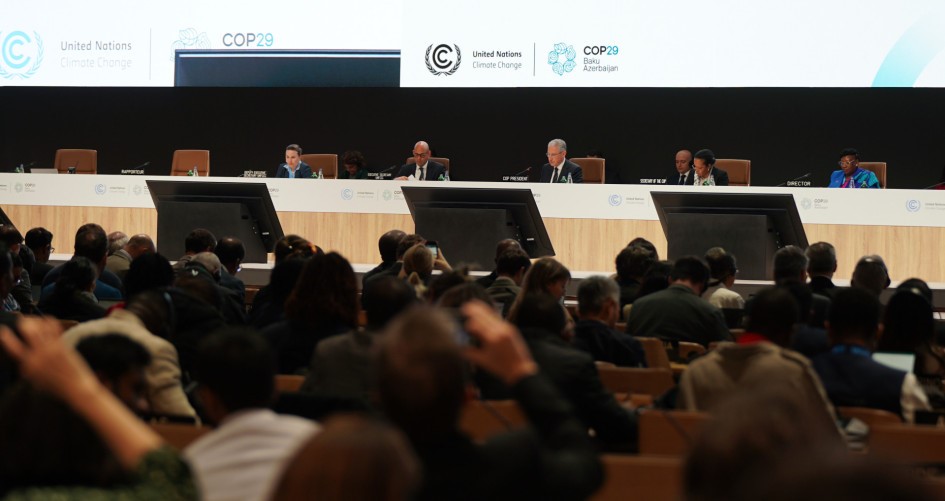
- 26 Nov 2024
In News:
The 29th UN Climate Change Conference (COP29), held in Baku, Azerbaijan, focused on enhancing climate finance, adaptation measures, and global cooperation.
Key Outcomes of COP29:
- Climate Finance: A new goal was set to triple climate finance for developing countries to USD 300 billion annually by 2035. The total climate finance target aims for USD 1.3 trillion annually by 2035.
- Carbon Markets: The conference operationalized Article 6 of the Paris Agreement, which establishes frameworks for carbon credit trading between countries. It also launched the Paris Agreement Crediting Mechanism, ensuring safeguards for human rights and the environment.
- Transparency and Adaptation: COP29 saw 13 countries submit their Biennial Transparency Reports, promoting greater accountability. The Baku Adaptation Roadmap was launched to speed up National Adaptation Plans (NAPs) in Least Developed Countries (LDCs).
- Gender and Inclusivity: A new Gender Action Plan was developed, and the Lima Work Programme on Gender was extended for another 10 years. Over 55,000 people, including civil society, Indigenous peoples, and youth, participated.
- Global Climate Action: The 2024 Yearbook of Global Climate Action highlighted the role of non-Party stakeholders like businesses and sub-national actors in combating climate change.
India’s Role at COP29: India played an active role in highlighting resilient infrastructure initiatives like the Coalition for Disaster Resilient Infrastructure (CDRI) and advocated for financial resources to support Small Island Developing States (SIDS). India also pushed for solar energy adoption through the International Solar Alliance (ISA) and promoted gender-inclusive climate policies. India co-hosted the LeadIT summit with Sweden, focusing on industrial decarbonization.
Challenges at COP29:
- Inadequate Finance: Despite ambitious targets, many countries felt the financial commitments were insufficient and distant.
- Private Sector Dependency: The reliance on private sector contributions raised concerns about the reliability of funding.
- Emission Reduction Gaps: There was a lack of sufficient pledges to meet the 1.5°C global warming target, with rising emissions.
- Geopolitical Conflicts: Disputes over issues like the Carbon Border Adjustment Mechanism (CBAM) hindered progress.
India’s Carbon Credit Framework:
India introduced the Energy Conservation (Amendment) Act, 2022, establishing a domestic carbon market and setting a legislative framework for carbon credit trading. This aligns with India’s NDCs and aims to support sustainable growth while reducing emissions. However, concerns about the integrity of carbon credits and potential "greenwashing" need to be addressed through rigorous verification systems.
Conclusion:
COP29 marked progress in scaling up climate finance, carbon markets, and adaptation efforts, but significant challenges remain, especially in finance, emission reductions, and geopolitical cooperation. India's initiatives in carbon credit frameworks and resilience are steps toward a sustainable future. Moving forward, a collaborative, transparent, and adaptive approach is crucial to meet global climate goals.
Challenges in Municipal Financing

- 25 Nov 2024
Introduction
Municipal corporations (MCs) in India are essential service providers in urban areas, but they face severe financial constraints, which hinder their ability to provide quality services. While urban India contributes almost 60% of the nation's economic output, MCs are heavily reliant on state and central government transfers, limiting their financial autonomy and operational capacity.
Key Issues in Municipal Financing
- Limited Revenue Generation
- Low Property Tax Revenues: Property tax, the main source of municipal revenue, contributes only 0.12% of GDP, a figure that reflects poor tax collection mechanisms and outdated property valuation systems.
- Revenue Concentration: Over 58% of municipal revenue comes from the top 10 cities, highlighting fiscal disparity between urban areas.
- Dependence on Government Transfers: Municipalities rely significantly on state and central transfers, constituting a large portion of their revenue. This reduces their ability to plan and execute long-term projects independently.
- Inefficiency in Tax and Fee Collection
- Ineffective Property Tax Systems: Existing tax formulas do not reflect actual property valuations, leading to under-taxation and revenue loss.
- Inadequate User Charges: Fees for essential services like water supply, sanitation, and waste management are not regularly adjusted, impacting cost recovery and service quality.
Strategies for Strengthening Urban Local Bodies (ULBs)
- Enhancing Revenue Sources
- Property Tax Reforms: Implementing GIS-based property tax mapping and linking tax rates to actual property valuations can improve tax compliance and revenue generation.
- Rationalising User Charges: Regular adjustments to service fees for water, sanitation, and waste management can ensure cost recovery and better service delivery.
- Reducing Dependence on Transfers
- State and Central Transfers: A rule-based framework for government transfers, accounting for inflation and city growth, can ensure predictability and adequate compensation for MCs.
- Boosting Non-Tax Revenues: MCs can increase income from user fees (e.g., for urban transport and waste management) and explore public-private partnerships (PPPs) to enhance service delivery.
- Leveraging Technology for Efficiency
- Digitalisation and Automation: Streamlining processes through technology can reduce inefficiencies, cut down on waste, and free up resources for capital expenditure.
- Monitoring Systems: Improved monitoring and reporting can reduce pilferage, enhance revenue collection, and ensure accountability.
Fiscal Management and Innovative Financing
- Municipal Bonds and Innovative Financing
- Larger MCs are already using municipal bonds to fund infrastructure projects. Smaller cities can adopt similar financing instruments to diversify funding sources and attract private investment.
- Public-Private Partnerships (PPPs): Fostering partnerships in sectors like urban transport and waste management can attract private investment and reduce the financial burden on MCs.
- Resource Pooling for Infrastructure Projects
- MCs can collaborate to pool resources for large-scale projects, such as renewable energy or urban transport initiatives, overcoming fiscal constraints that individual corporations face.
Government Initiatives for Urban Governance
- Citizen-Centric Programs
- Swachh Sarvekshan (2017) promotes citizen participation to improve urban cleanliness.
- Swachh Bharat Idea Book empowers citizens to propose innovative solutions to urban challenges.
- Performance-Based Indices
- Ease of Living Index (2017) and the Municipal Performance Index (2019) assess urban quality of life, service delivery, and governance, encouraging better performance in ULBs.
Conclusion
Empowering urban local bodies is crucial for effective urban governance and development. By improving revenue generation through reforms, reducing dependence on transfers, and adopting innovative financing mechanisms, municipal corporations can enhance their capacity to meet the growing demands of urbanization. Collaborative efforts between the government, civil society, and academia are essential to ensure sustainable urban development and better living conditions for urban residents.
Reimagining Governance with AI: The Promise of GovAI

- 20 Nov 2024
In News:
India's rapid digital transformation, coupled with the advancements in Artificial Intelligence (AI), presents a unique opportunity to reimagine governance. The concept of GovAI—using AI to enhance public administration—holds the potential to revolutionize governance, improve efficiency, and create more responsive and inclusive public systems.
Digital Transformation in Governance
- Evolution of Digital Public Infrastructure (DPI)
- Over the past decade, India has made significant strides in digital governance through the development of Digital Public Infrastructure (DPI). DPI has reduced inefficiencies, enhanced transparency, and improved service delivery, transforming India's governance landscape.
- Impact of AI on Governance
- As AI becomes a critical enabler in various sectors, its application to governance promises to deliver more efficient, inclusive, and responsive government services. The potential of AI lies in its ability to provide more with less, driving innovation across key public services.
Key Trends Driving GovAI
- Rapid Digitalization of India
- Currently, 90 crore Indians are connected to the Internet, with projections indicating 120 crore by 2026, positioning India as the most connected country globally.
- Digitalization serves as the backbone for AI-driven governance, enabling efficient data collection, analysis, and informed policy-making.
- Data as a Valuable Resource
- The rapid digitalization of India has led to the generation of vast amounts of data. This data serves as the fuel for AI models, which can be used to enhance governance.
- Programs like the IndiaDatasetsProgramme aim to harness government datasets for AI development while safeguarding data privacy through legislation.
- Demand for Efficient Governance
- The post-COVID world has underscored the need for governments to deliver better outcomes with fewer resources. AI has the potential to optimize the use of public resources, enabling more efficient and targeted governance.
India’s Leadership in AI-Driven Governance
- Positioning India as a Global Leader
- India’s digital governance initiatives have placed it at the forefront of AI adoption in the public sector. Through GovAI, India can solidify its position as a global leader in using technology for public good.
- As the Chair of the Global Partnership on AI (GPAI), India is advocating for the inclusive development of AI to ensure that it benefits all nations, not just a select few.
- Role of Innovation Ecosystem
- India’s innovation ecosystem, comprising startups, entrepreneurs, and tech hubs, can play a crucial role in driving the development of AI models, platforms, and apps for governance.
- A strong partnership between the government and private sector is essential to successfully deploy AI solutions across various sectors of governance.
Potential Benefits of GovAI
- Enhanced Efficiency and Service Delivery
- AI-powered tools, such as chatbots, can provide citizens with 24/7 assistance, streamlining public service delivery and reducing waiting times.
- AI can help in automating processes and improving the overall efficiency of government operations.
- Data-Driven Decision-Making
- AI can analyze large datasets to make informed policy decisions and design targeted interventions in sectors like healthcare, education, and social welfare.
- Data-driven insights can enhance the effectiveness of welfare schemes, improving outcomes for marginalized communities.
- Increased Transparency and Accountability
- AI can enhance transparency in governance by minimizing human intervention in processes, thus reducing corruption and ensuring efficient use of public resources.
- Predictive analytics and real-time data monitoring can enable proactive governance, preventing issues before they escalate.
Challenges and Drawbacks of GovAI
- Privacy Concerns
- The use of AI in governance requires the collection and analysis of vast amounts of personal data, raising concerns about data privacy and surveillance.
- Robust data protection laws must be enforced to ensure citizens' data is handled responsibly.
- Accountability and Bias
- AI systems may produce biased outcomes depending on the data they are trained on. Ensuring accountability for decisions made by AI systems remains a challenge, particularly when errors or biases occur.
- Transparent mechanisms must be established to hold AI systems accountable for their actions.
- Increased State Control and Surveillance
- The integration of AI in governance could lead to increased state control, potentially compromising individual freedoms. Ensuring that AI is used responsibly to balance power between the government and citizens is critical.
- Digital Divide
- The benefits of AI in governance may not be evenly distributed across the population, exacerbating the digital divide.
- Efforts must be made to ensure that marginalized communities, without access to digital technologies or skills, are not left behind.
Conclusion
- Balancing Benefits and Risks
- The integration of AI into governance systems presents significant benefits, including enhanced efficiency, transparency, and proactive governance. However, there are challenges related to privacy, accountability, and state control.
- To ensure AI serves the public good, India must implement strong regulatory frameworks, promote transparency, and develop ethical AI systems that respect citizens’ rights and freedoms.
- Moving Toward Maximum Governance
- AI can help realize the vision of maximum governance, enabling more effective and targeted interventions across sectors like healthcare, security, education, and disaster management.
- The success of GovAI will depend on a trusted partnership between the government, private sector, and innovation ecosystem, ensuring that AI technology serves the larger public interest.
Khap Panchayats: Evolving Towards Modern Governance and Justice
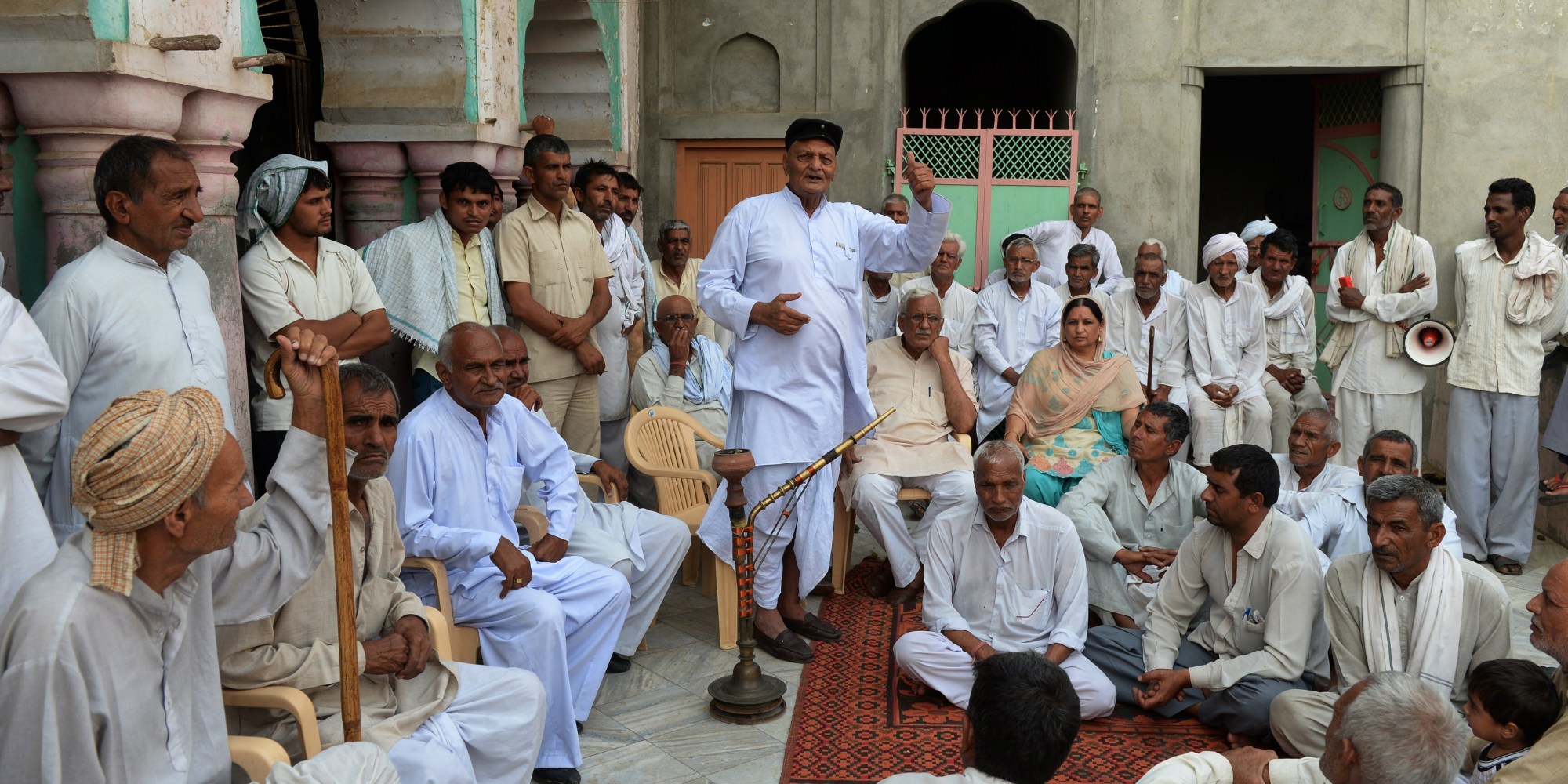
- 17 Nov 2024
Why in the News?
Khap Panchayats have attracted attention due to their evolving role in addressing key socio-economic issues like unemployment, education, and rural development. Modernization efforts are underway to regulate these traditional councils, integrating them into formal Alternative Dispute Resolution (ADR) systems for better governance, accountability, and social justice.
What are Khap Panchayats?
Definition and Origin:
Khap Panchayats are community-based councils primarily found in North India, particularly in Haryana, Uttar Pradesh, and parts of Rajasthan. These informal bodies, composed of elders from kinship groups (Khaps), have historically served as local governance bodies that resolve disputes within their communities. Their origins trace back centuries and they function alongside formal legal systems, often prioritizing customary norms over constitutional law.
Historical Role:
Historically, Khap Panchayats have maintained social order in rural areas, acting as forums for dispute resolution related to marriage, property, and community matters. While their decisions were respected within their communities, they operated parallel to formal courts, and their influence was often seen as a stabilizing force in rural society. However, their structure has also contributed to the perpetuation of patriarchal practices and social exclusion.
Issues with Khap Panchayats
- Patriarchal Practices:Khap Panchayats have often been associated with gender inequality. They enforce rigid social norms that limit women's autonomy, particularly in matrimonial matters, inheritance rights, and personal freedoms. This has led to criticism for their role in suppressing women's rights.
- Honor Killings and Social Conservatism:Khap Panchayats are notorious for opposing inter-caste and same-gotra marriages, at times even endorsing honor killings to preserve social order. Such practices are violations of fundamental rights and personal freedoms guaranteed by the Indian Constitution.
- Legality Concerns:The decisions of Khap Panchayats often clash with constitutional values such as equality, personal liberty, and dignity. Their informal judgments lack legal validity and frequently violate the rule of law, raising significant concerns about their adherence to India’s legal framework.
- Caste-based Discrimination:Khap Panchayats have been criticized for reinforcing caste hierarchies, which leads to discrimination and exclusion of marginalized communities. Their focus on preserving traditional caste structures often results in the oppression of the vulnerable, particularly lower-caste groups.
Gender Dynamics and Evolving Roles of Khap Panchayats
In recent years, some Khap Panchayats have started to show more progressive and inclusive stances, particularly in promoting gender justice:
- Support for Women Athletes:Khap Panchayats have begun to recognize and celebrate the achievements of women, particularly in sports. Several Khap bodies have felicitated women sportspersons, contributing to a growing culture of sports among rural women. This marks a shift from their traditionally patriarchal stance.
- Promoting Gender Justice:Notably, the MehamChaubisiKhap in Haryana has played a significant role in advocating for women’s rights and gender equality. It was involved in supporting the 2023 wrestlers' protest against sexual harassment, demonstrating a shift towards gender-related activism and social reform.
Supreme Court Ruling on Khap Panchayats:
In the landmark Shakti Vahini v. Union of India case (2018), the Supreme Court of India addressed the issue of honor killings and inter-caste marriages. The Court emphasized that honor killings violate fundamental rights and called for strict measures to prevent such crimes. The Court further directed state governments to establish special protection cells for couples facing threats from their families and communities. This ruling underscored the importance of personal liberty and freedom of choice, regardless of community or caste.
What is Alternative Dispute Resolution (ADR)?
Definition and Importance:
Alternative Dispute Resolution (ADR) refers to methods of resolving disputes without resorting to formal litigation. These methods include mediation, arbitration, and conciliation, all of which encourage cooperative problem-solving and mutually agreeable solutions. ADR is particularly important in India due to the overburdened judicial system, which faces a backlog of cases and delays.
ADR offers several advantages, including:
- Cost-effectiveness
- Confidentiality
- Flexibility
- Improved relationships between parties involved
Types of ADR Mechanisms:
- Arbitration: A formal process where an arbitrator resolves disputes and their decision is legally binding.
- Conciliation: A third-party neutral assists the parties in reaching an agreement, and the recommendations can be accepted or rejected.
- Mediation: A mediator facilitates communication between disputing parties, helping them reach a voluntary and mutually agreeable resolution.
- Negotiation: A direct negotiation between the parties without third-party involvement, aiming for a mutually acceptable settlement.
Integrating Khap Panchayats into the Formal ADR System
Given the potential of Khap Panchayats as community-based governance bodies, integrating them into the formal ADR framework can significantly enhance their role in dispute resolution. Here are some strategies for modernizing Khap Panchayats:
- Legal Recognition of ADR Role:Khap Panchayats can be legally recognized within the ADR framework, formalizing their role in mediation and dispute resolution, ensuring their decisions align with constitutional norms and human rights.
- Training and Capacity Building:Khap leaders can undergo training in ADR techniques such as mediation and arbitration, equipping them with skills to resolve conflicts impartially and in line with legal standards. This would help transition Khaps from informal bodies to more structured and legally compliant dispute resolution mechanisms.
- Legal Regulation and Oversight:Regulations can be put in place to define the scope and limitations of Khap Panchayats' authority, ensuring their decisions do not violate human rights or the constitution. Oversight mechanisms should be established to monitor their actions and prevent practices like honor killings or forced marriages.
- Shift Towards Developmental Roles:Some Khap Panchayats are already advocating for progressive reforms in areas like unemployment, education, and rural development. By focusing on these issues, Khap Panchayats can serve as agents of social change and contribute to community development.
- Awareness and Accountability:Awareness campaigns can educate rural communities about constitutional rights and the legal system, emphasizing the importance of formal legal frameworks and human rights. At the same time, Khap Panchayats should be held accountable for actions that undermine justice or equality.
- Collaboration with Formal Institutions:Khap Panchayats can collaborate with local governance bodies and judicial institutions, ensuring that their decisions align with the rule of law and contribute to social justice. This would enhance their role in inclusive decision-making and legally sound governance.
Conclusion
Khap Panchayats, with their deep-rooted history and influence, have the potential to evolve into modern governance institutions. By integrating them into the formal ADR framework, aligning their practices with constitutional values, and focusing on community development, they can contribute positively to dispute resolution and social reform in rural India. This transformation will require legal regulation, training, oversight, and awareness to ensure that Khap Panchayats function as effective, equitable bodies that respect the fundamental rights of all individuals.
The Need for More Women in Politics

- 15 Nov 2024
In News:
India, the world's largest democracy, is at a crucial juncture where women’s active political participation is essential for holistic development and true democratic engagement. The year 2024 demands increased involvement of women in politics to address issues of gender inequality and ensure comprehensive policy representation.
Current Status of Women’s Political Representation in India
Women in Parliament
- Initial Representation: In 1952, women accounted for only 4.41% of the Lok Sabha. This gradually rose to around 14.36% in the 2019 elections.
- Recent Trends: In the 2024 elections, women made up approximately 16% of the Lok Sabha, with 74 women MPs, 43 of whom are first-time representatives.
Women in State Legislatures
- Representation in state legislative assemblies remains low, with the highest percentages in Chhattisgarh (14.4%), West Bengal (13.7%), and Jharkhand (12.4%).
Global Comparison
- According to the Inter-Parliamentary Union (IPU), India ranks lower than many countries in terms of female representation in parliament, with global averages standing at 26.1%. India lags behind several African and South Asian nations.
Importance of Women’s Political Empowerment
- Enhancing Governance and Accountability: Political empowerment of women ensures better representation of gender-sensitive issues, promoting accountability in governance.
- Breaking Patriarchal Norms: Increasing women’s participation helps challenge the patriarchal structure that dominates Indian politics and promotes inclusive governance.
- Policy and Social Impact: Women in politics are more likely to advocate for policies that address issues like health, education, and gender equality, leading to improved societal welfare.
- Economic Benefits: Studies suggest that women in political leadership tend to improve economic outcomes for their constituencies by prioritizing social infrastructure.
Barriers to Women’s Political Participation
- Gender Gaps in Political Ambition: Women are less likely to pursue political careers due to gender conditioning, family pressures, and stereotypes about leadership abilities.
- Patriarchal Culture: A deeply ingrained patriarchal society hampers women’s political involvement, with male-dominated party structures and social norms limiting opportunities.
- High Election Costs: The financial burden of running for office often discourages women from contesting elections due to unequal access to resources.
- Male Gatekeepers in Politics: Political parties often show a preference for male candidates, especially for higher-profile positions, hindering the rise of women leaders.
- Criminalisation and Corruption in Politics: Growing criminalisation in politics and lack of political education further alienates women from the political process.
Key Legislative and Constitutional Measures for Women’s Political Empowerment
Legislative Measures
- Nari Shakti VandanAdhiniyam (2023): Provides 33% reservation for women in the Lok Sabha and state assemblies.
- 73rd and 74th Amendments (1992): Introduced 33% reservation for women in Panchayats and Municipalities.
- Gender-Neutral Rules: Lok Sabha adopted gender-neutral rules in 2014, promoting inclusivity in legislative procedures.
Constitutional Provisions
- Article 14 and 15: Ensure equality and non-discrimination, fundamental to women’s political participation.
- Article 243D: Mandates 33% reservation for women in Panchayats.
International Commitments
- CEDAW (1979): Advocates for women’s participation in political and public life.
- Beijing Platform (1995) and SDGs (2015): Call for removing barriers to women’s participation in politics.
Measures for Promoting Women’s Political Participation
- Quotas and Reservations: Ensuring mandatory quotas for women candidates in party tickets and legislative bodies can help bridge gender gaps.
- Capacity Building and Training: Offering political training programs for women can empower them with the skills and resources necessary for effective political participation.
- Strengthening Grassroots Movements: Support for Self-Help Groups (SHGs) and Panchayati Raj Institutions (PRIs) can build leadership among women at the local level.
- Supportive Political Ecosystem: Political parties should be encouraged to nominate women for higher office positions, such as the Rajya Sabha or state legislative councils.
- Raising Public Awareness: Public awareness campaigns focusing on the importance of women in politics can shift societal attitudes and garner wider public support.
Conclusion:
As India moves forward, the active participation of women in politics is not merely a matter of equity but an essential building block for a vibrant, inclusive, and effective democracy. Through structural reforms, public awareness, and the promotion of female leadership, India can strengthen its democratic framework, ensuring that all citizens, regardless of gender, have an equal stake in shaping the nation's future.
Significance of LignoSat
- 12 Nov 2024
Introduction
- LignoSat is the world's first satellite constructed with wood, developed to test the viability of using timber as a sustainable material in space exploration.
- Launched on November 5, 2024, the satellite was sent to the International Space Station (ISS) aboard a SpaceX Dragon cargo capsule and will be released into orbit after a month for a six-month test.
What is LignoSat?
- Dimensions: LignoSat measures 4 inches (10 cm) on each side and weighs 900 grams.
- Material Composition: The satellite features panels made from magnolia wood using traditional Japanese craftsmanship, without screws or glue.
- Development Collaboration: LignoSat was developed by Kyoto University and Sumitomo Forestry, in collaboration with various researchers and space organizations.
Purpose and Objectives of the Mission
- Testing Timber in Space:
- The primary goal is to study how wood performs in the extreme conditions of space, where temperatures fluctuate dramatically between -100°C to 100°C.
- The satellite will also assess how wood interacts with space radiation and its potential to reduce the impact of radiation on sensitive electronics, such as semiconductors.
- Space Sustainability:
- LignoSat aims to demonstrate that wood can be a sustainable, renewable alternative to metals (like aluminium) traditionally used in spacecraft construction.
- The satellite will help determine if wood can be used in future space missions, potentially reducing reliance on non-renewable materials.
Testing the Durability of Wood in Space
- Challenges of Space Environment:
- Space is an extremely harsh environment with extreme temperature variations, exposure to radiation, and the lack of water and oxygen, all of which affect material durability.
- Unlike Earth, where wood decomposes due to moisture and oxygen, space's vacuum conditions could potentially preserve the wood's integrity, providing valuable insights into its durability.
- Previous Use of Wood in Space:
- Wood has already been tested in space applications: cork has been used on spacecraft to withstand re-entry conditions.
- The LignoSat mission builds on this knowledge, aiming to test wood's performance in space's high-radiation and vacuum environment.
Potential Advantages of Using Wood in Space Exploration
- Sustainability and Environmental Benefits:
- Unlike conventional aluminium satellites, which generate harmful pollutants upon re-entry (e.g., aluminium oxides), LignoSat's wooden components will degrade in a more environmentally friendly manner, minimizing atmospheric pollution.
- As space exploration increases, particularly with mega-constellations (e.g., SpaceX’s Starlink), space debris management becomes critical. Using wood could reduce the environmental impact of satellite disposal.
- Renewable Resource:
- Wood is a renewable resource, which offers a potential solution to the growing demand for materials used in space technology.
- Kyoto University researchers have long been exploring the idea of building habitats on the Moon and Mars using timber, with LignoSat seen as a stepping stone to proving the material's space-grade capabilities.
LignoSat's Design and Construction
- Hybrid Construction:
- While the outer panels of LignoSat are made from magnolia wood, the satellite still incorporates traditional aluminium structures and electronic components inside.
- The hybrid construction allows researchers to compare the performance of wood against conventional materials used in spacecraft.
- Testing Methods:
- LignoSat will orbit Earth for six months and monitor the wood’s reaction to space conditions, providing valuable data for future space missions.
- Sensors embedded in the satellite will track various environmental factors, such as radiation exposure, temperature fluctuations, and the structural integrity of the wood.
The Long-Term Vision: Building Timber Habitats in Space
- The research team, led by Takao Doi (astronaut and Kyoto University professor), envisions a future where timber is used for constructing space habitats on the Moon and Mars.
- The team’s ultimate goal is to plant trees in space and develop timber houses on extraterrestrial bodies, providing a sustainable, self-sufficient environment for humans in space.
Broader Implications for Space Exploration
- Sustainability in Space Missions:
- LignoSat represents an innovative step toward more sustainable space technologies by investigating eco-friendly materials that can minimize the environmental impact of space missions.
- It aligns with global efforts to make space exploration more sustainable, especially as space tourism and colonization plans grow.
- Future Prospects:
- If successful, LignoSat could pave the way for wood-based materials being used in spacecraft construction, not only for satellites but also for space stations and future human habitats in space.
Conclusion
- LignoSat’s mission marks a significant milestone in space exploration by exploring wood as a sustainable material in space technology.
- As the first wooden satellite, its results could pave the way for more eco-friendly, renewable materials in future space missions, aligning with global goals for sustainability and reducing space-related pollution.
Uttar Pradesh Board of Madarsa Education Act, 2004

- 09 Nov 2024
In News:
The Supreme Court recently upheld the constitutional validity of the Uttar Pradesh Board of Madarsa Education Act, 2004 (also called the Madarsa Act), while striking down certain provisions related to the granting of higher education degrees. The Court overturned the Allahabad High Court's previous decision, which had deemed the Act unconstitutional on the grounds that it violated the principle of secularism.
What is the Madarsa Act?
The Madarsa Act provides a legal framework for regulating madrasas (Islamic educational institutions) in Uttar Pradesh. The Act:
- Establishes the Uttar Pradesh Board of Madarsa Education, which oversees the curriculum and examinations for madrasas.
- Ensures that madrasas follow the National Council of Educational Research and Training (NCERT) curriculum for mainstream secular education alongside religious instruction.
- Empowers the state government to create rules for regulating madrasa education.
Allahabad High Court's Ruling
In March 2024, the Allahabad High Court declared the Madarsa Act unconstitutional, citing:
- Violation of secularism: The Court argued that the Act's emphasis on compulsory Islamic education, with modern subjects being optional, discriminated on religious grounds, violating the secular nature of the Constitution.
- Right to Education: The Court also claimed that the Act denied quality education under Article 21A, which guarantees free and compulsory education to children.
- Higher Education Degrees: The Act's provisions allowing the granting of Fazil and Kamil degrees were found to conflict with the University Grants Commission Act, 1956, which regulates higher education.
Supreme Court's Ruling
The Supreme Court overturned the Allahabad High Court's decision on several grounds:
- Basic Structure Doctrine: The Court clarified that the basic structure doctrine, which applies to constitutional amendments, does not apply to ordinary legislation like the Madarsa Act. Therefore, a law cannot be struck down simply for violating secularism unless explicitly prohibited by the Constitution.
- State's Authority to Regulate Education: The Court held that the state has the right to regulate education in minority institutions, as long as the regulation is reasonable and rational. It emphasized that the Madarsa Act does not deprive these institutions of their minority character.
- Right to Education for Minority Institutions: Referring to a 2014 decision, the Court ruled that the Right to Education Act (RTE) does not apply to minority institutions, as it would undermine their right to impart religious education and self-administer.
Striking Down Higher Education Provisions
While upholding most of the Act, the Supreme Court struck down the provisions related to higher education degrees (Fazil and Kamil). It ruled that:
- Section 9 of the Act, which allowed the Board to grant these degrees, is in conflict with the University Grants Commission Act, which only permits degrees to be awarded by universities recognized by the UGC.
Implications of the Ruling
- Regulation of Madrasa Education: The ruling affirms the state's authority to ensure quality education in madrasas, balancing religious instruction with secular subjects.
- Protection of Minority Rights: By upholding the Madarsa Act, the Court protected the rights of religious minorities to run educational institutions while ensuring they meet educational standards.
- Focus on Inclusivity: The judgment emphasizes the integration of madrasas within the broader educational framework, ensuring that madrasa students receive quality education.
In conclusion, the Supreme Court's decision supports the regulation of madrasa education while safeguarding the rights of minority institutions, except in areas related to the granting of higher education degrees, which remain under the jurisdiction of the UGC Act.
RBI brings back 102 tonnes gold from BoE; 60 per cent reserves in India

- 04 Nov 2024
In News:
England over the past two-and-a-half years, reflecting a strategic shift in its approach to safeguarding gold reserves. This move marks a significant increase in the RBI's domestic gold holdings.
Rise in the RBI's Domestic Gold Holdings
- Current Status (September 2024):The RBI's domestic gold reserves have grown to 510.46 metric tonnes, up from 295.82 metric tonnes in March 2022.
- Reduction in Gold Held Abroad:The gold held under the custodianship of the Bank of England has decreased to 324 metric tonnes from 453.52 metric tonnes in March 2022.
- Gold as a Share of Foreign Exchange Reserves:The proportion of gold in India's total foreign exchange reserves increased from 8.15% in March 2024 to 9.32% in September 2024.
Gold Kept in the Bank of England
- Overview of the Bank of England's Gold Vault:The Bank of England is home to one of the largest gold vaults in the world, second only to the New York Federal Reserve, housing around 400,000 bars of gold.
- India’s Gold Held Abroad:The RBI continues to retain 324 metric tonnes of its gold with the Bank of England and the Bank for International Settlements (BIS).
- Additional Gold Management:Around 20 tonnes of gold are managed through gold deposit schemes.
- Strategic Role of London’s Gold Market:Storing gold in London provides immediate access to the global London bullion market, enhancing liquidity for India’s gold assets.
Historical Context of India’s Gold Holdings
- 1991 Balance of Payments Crisis:During a financial crisis in 1991, India had to send 47 tonnes of gold to the Bank of England to secure loans for repaying international creditors.
RBI’s Strategy to Bring Gold Back to India
- Global Trend of Central Banks Buying Gold:Since the imposition of U.S. sanctions on Russia in 2022, central banks globally have been increasing their gold reserves as a hedge against inflation and to reduce reliance on the U.S. dollar. India has outpaced other G20 nations in this trend, surpassing Russia and China in gold purchases.
- De-dollarisation:This shift is part of a broader strategy of de-dollarisation, aiming to diversify away from the U.S. dollar amidst rising gold prices and growing geopolitical tensions.
Significance of Repatriating Gold to India
- Sign of Economic Strength
- Recovery from the 1991 Crisis:The decision to repatriate gold reflects a significant improvement in India's economic position, a stark contrast to the 1991 economic crisis when India had to pledge gold for financial survival.
- Optimizing Financial Resources
- Reducing Storage Costs:Storing gold domestically allows the RBI to save on storage fees paid to foreign custodians, such as the Bank of England.
- Strategic Significance
- Enhanced Resilience Amid Global Instability:By repatriating its gold, India enhances its strategic autonomy and strengthens its economic position in a world of rising uncertainties and currency volatility.
RBI's Capacity to Safeguard Gold Domestically
- Increasing Domestic Storage Capacity:The RBI has been increasing its domestic capacity for gold storage to accommodate rising reserves and reduce dependence on foreign gold safekeeping facilities.
- Current Foreign Exchange Reserves:As of October 2024, India’s total foreign exchange reserves stand at $684.8 billion, sufficient to cover over 11.2 months of imports.
Diversification of Foreign Exchange Reserves
- Mitigating Currency Risks:By increasing gold reserves, India diversifies its foreign exchange holdings, reducing reliance on any single currency and shielding itself from global currency fluctuations and economic volatility.
- Gold as a Stable Asset:Gold serves as a stable asset, providing a safeguard against global economic shocks, and balances India’s reserves portfolio.
Gold as a Hedge against Inflation
- Preserving Wealth amid Inflation:Gold is traditionally viewed as a hedge against inflation, maintaining or appreciating in value when other currencies weaken. By increasing its gold reserves, India positions itself to better withstand the adverse effects of inflation and ensure long-term financial stability.
Conclusion
The repatriation of gold by the RBI reflects a strategic move to bolster India's economic strength and diversify its financial assets. The decision to bring gold back to India not only signifies an improvement in India's economic fundamentals but also aligns with global trends of central banks increasing their gold reserves to ensure long-term stability and reduce reliance on the U.S. dollar.
The right to die with dignity
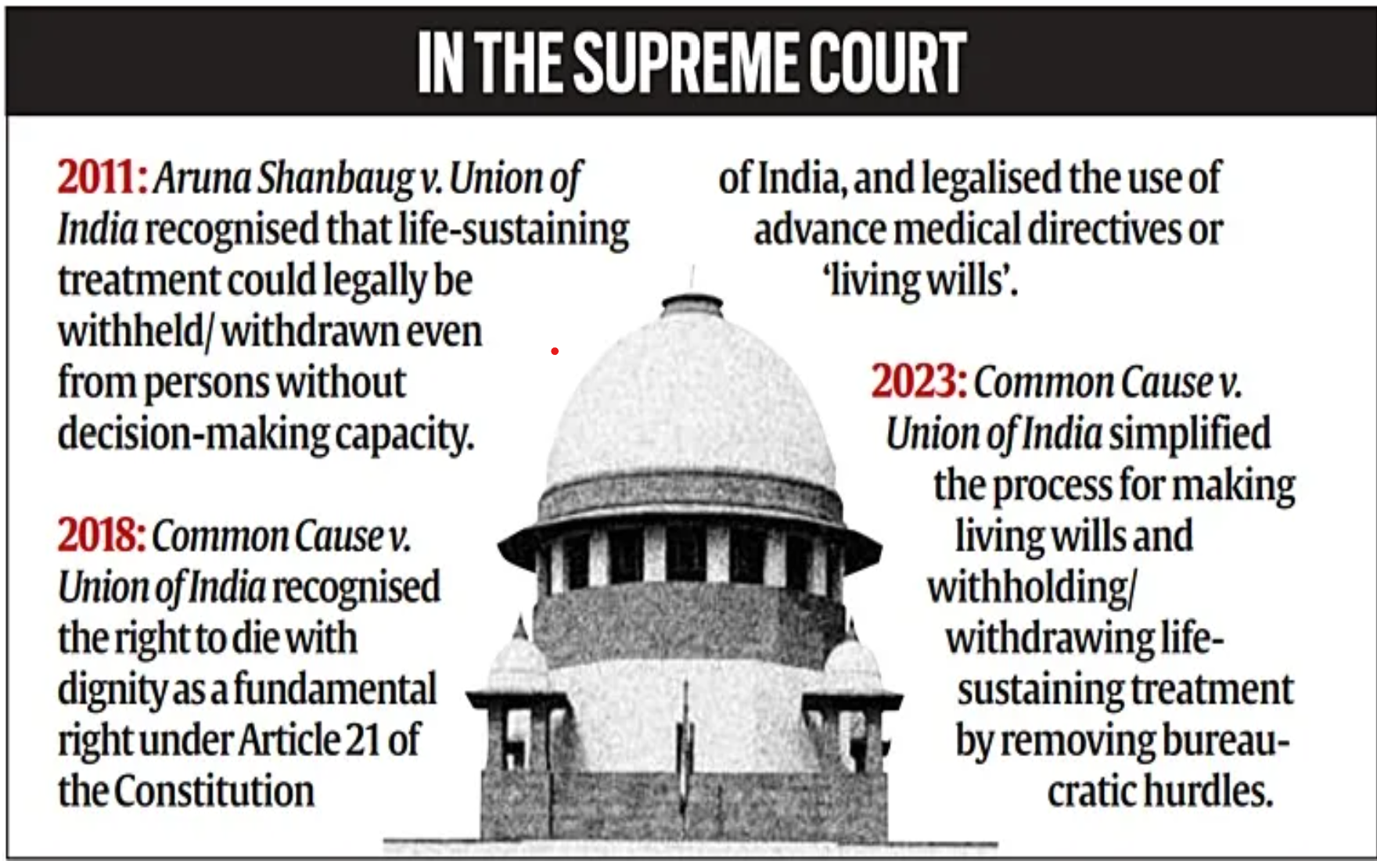
- 26 Oct 2024
In News:
- The Ministry of Health and Family Welfare's draft guidelines (October 2024) aim to implement the Supreme Court's 2018 and 2023 orders on the right to die with dignity.
Legal Context: Supreme Court Rulings and Constitutional Rights
- Right to Refuse Treatment:
- Common Law & Article 21: The right to refuse medical treatment is grounded in common law and is now recognized as a fundamental right under Article 21 of the Indian Constitution, following the 2018 Supreme Court judgment in Common Cause v. Union of India.
- Supreme Court Rulings: The court's rulings in 2018 and 2023 affirmed that individuals have the constitutional right to refuse life-sustaining treatment and to die with dignity.
Withholding and Withdrawing Life-Sustaining Treatment
- Definition and Meaning:
- What Is Life-Sustaining Treatment? Life-sustaining treatments, such as ventilators and feeding tubes, artificially replace vital bodily functions to sustain life.
- Withholding/Withdrawal: This refers to discontinuing these treatments when they no longer improve the patient's condition or merely prolong suffering.
- When Is It Done?
- End-of-Life Care: Withholding or withdrawing treatment is considered when further medical intervention is futile and would only artificially prolong the dying process.
- Focus on Comfort: After withdrawing life-sustaining measures, the focus shifts to palliative care to alleviate pain and suffering.
Understanding Euthanasia and Misconceptions
- What Is Euthanasia?
- Definition: Euthanasia refers to the intentional ending of a terminally ill patient’s life by medical professionals to relieve suffering.
- Passive Euthanasia Misconception: In India, the term "passive euthanasia" is often mistakenly used to describe withholding or withdrawing life-sustaining treatment, but this does not involve the active killing of the patient.
- Legal Framework: The Indian Council of Medical Research (ICMR) clarified in 2018 that "passive euthanasia" is not a legally accepted practice in the country.
The Role of Doctors: Ethical Dilemmas and Shared Decision-Making
- Is Withdrawing Treatment "Giving Up" on the Patient?
- Not Abandonment: Withdrawing life-sustaining treatment is not about abandoning the patient but recognizing when further interventions would cause unnecessary suffering.
- Palliative Care: The patient’s comfort and dignity are prioritized through palliative care, which focuses on pain management and emotional support for both the patient and family.
- Doctors' Ethical Responsibility:
- Shared Decision-Making: The process encourages a collaborative approach between doctors and the patient’s family or surrogate decision-makers. This joint decision-making ensures that the wishes of the patient are respected and relieves the doctor from bearing sole responsibility for life-and-death decisions.
Living Wills and Advance Medical Directives
- What Is a Living Will?
- Definition: A living will is a legal document where a person outlines their medical preferences in the event they lose decision-making capacity.
- Eligibility and Process: Individuals aged 18 or older, who are capable of making decisions, can draft a living will, naming at least two trusted surrogate decision-makers.
- Legal Requirements: The document must be signed in the presence of an executor, two witnesses, and notarized to be legally binding.
- 2023 Supreme Court Guidelines: The Court simplified the procedure for making living wills to ensure that the right to die with dignity is upheld.
Medical Procedure for Withholding or Withdrawing Treatment
- Supreme Court Guidelines
- The Supreme Court laid out a clear procedure for withholding or withdrawing life-sustaining treatment, emphasizing patient autonomy, expert assessments, and family consent.
- Primary and Secondary Medical Boards:
- Primary Medical Board: The treating hospital sets up a Primary Medical Board, consisting of the treating doctor and two subject-matter experts, to assess the patient's condition and determine if life-sustaining treatment is appropriate.
- Secondary Medical Board: A Secondary Medical Board, comprising independent experts, reviews the Primary Board's decision for added oversight.
- Consent from Family/Surrogate Decision-Makers:
- The patient’s wishes, as outlined in an advance directive or by a surrogate, must be respected, and their consent is essential for proceeding with treatment withdrawal.
- Judicial Oversight:
- Once the decision to withdraw treatment is made, the hospital is required to notify the local judicial magistrate, ensuring transparency and accountability.
Conclusion: Legal and Ethical Clarity in End-of-Life Care
- Shared Decision-Making: The process ensures that medical teams, families, and surrogate decision-makers collaborate, preventing any medical professional from facing moral or legal dilemmas alone.
- Protection of Autonomy: These frameworks and guidelines uphold patient autonomy, offering a legal and ethical pathway for terminally ill patients to exercise their right to die with dignity.
Biodiversity COP16
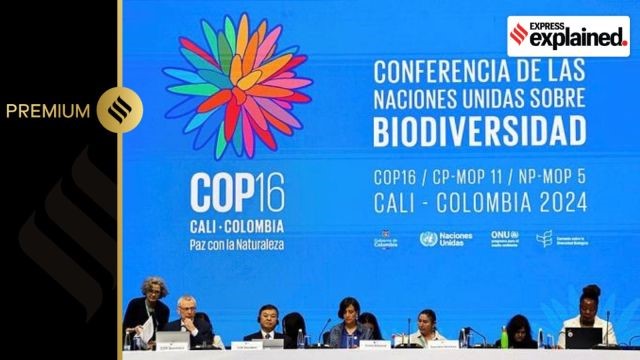
- 23 Oct 2024
In News:
The Convention on Biological Diversity (CBD), while historically overshadowed by climate change discussions, is now gaining increasing attention due to the growing recognition of the global biodiversity crisis. This evolving prominence highlights the need for urgent action to preserve ecosystems and halt biodiversity loss, which is intimately linked with the climate crisis.
Overview of the Convention on Biological Diversity (CBD)
- Origins and Objectives:
- The CBD emerged from the 1992 Rio Earth Summit, alongside the UN Framework Convention on Climate Change (UNFCCC).
- Main Goals:
- Protect global biodiversity.
- Restore ecosystems.
- Ensure equitable distribution of the benefits derived from biological resources.
- COP16 and the Kunming-Montreal Framework:
- The 16th Conference of Parties (COP16) marks the first meeting following the Kunming-Montreal Global Biodiversity Framework adopted at COP15 in 2022.
- The framework sets out four key goals and 23 targets to be achieved by 2030, including:
- Protect 30% of global lands and oceans by 2030.
- Restore 30% of degraded ecosystems by 2030.
The Growing Convergence Between Climate Change and Biodiversity
- Interlinkages Between Climate Change and Biodiversity:
- Mutual Impact:
- Climate change accelerates biodiversity loss by altering habitats and threatening species.
- In turn, ecosystem degradation contributes to climate change by releasing greenhouse gases (GHGs) from deforestation and soil degradation.
- Shared Drivers:
- Both crises are driven by unsustainable human activities, including over-exploitation of natural resources, deforestation, over-consumption, and pollution.
- Increasing Synergy:
- There is a growing realization of the need for integrated solutions that address both climate change and biodiversity loss simultaneously.
- Momentum for 30 x 30 Targets
- The 30 x 30 Commitment:
- The 30 x 30 targets are central to the Kunming-Montreal Framework, which includes:
- Conservation of 30% of the world's lands and oceans.
- Restoration of 30% of degraded ecosystems.
- These targets aim to ensure the preservation of biodiversity-rich areas and the restoration of degraded ecosystems globally by 2030.
- National Biodiversity Strategies and Action Plans (NBSAPs):
- Countries are required to develop and submit their NBSAPs (akin to Nationally Determined Contributions (NDCs) for climate change).
- As of now, only 32 countries have submitted their NBSAPs, with more expected during COP16.
- High Seas Treaty:
- A crucial agreement for achieving 30 x 30 targets is the High Seas Treaty (also called Biodiversity Beyond National Jurisdictions (BBNJ)), which focuses on:
- Establishing protected marine areas in biodiversity-rich regions beyond national jurisdictions.
- Ensuring regulation of human activities in these areas.
Access and Benefit Sharing: The Case of Genetic Resources
- Genetic Resources and Their Exploitation:
- The oceans, along with terrestrial ecosystems, harbor a wide variety of genetic resources that can be exploited for medical, commercial, and scientific purposes.
- Advances in biotechnology and digital sequencing of genetic material have raised issues about the equitable sharing of benefits from these resources.
- Nagoya Protocol and Benefit Sharing:
- The Nagoya Protocol (2010) set out guidelines for the access and fair sharing of benefits derived from genetic resources.
- At COP16, discussions will center on how genetic sequences (used in products such as medicines, crops, etc.) can be used fairly, ensuring that indigenous communities, who may be the original custodians of these resources, benefit equitably.
Finance Mechanisms for Biodiversity Conservation
- Financial Targets:
- One of the key goals of the Kunming-Montreal Framework is to mobilize $200 billion per year by 2030 for biodiversity conservation globally.
- Developed countries are expected to contribute $20 billion annually to developing nations, increasing to $30 billion by 2030.
- Phasing Out Harmful Subsidies:
- Countries are urged to eliminate perverse incentives that harm biodiversity, such as subsidies for:
- Over-fishing.
- Deforestation.
- Fossil fuel consumption.
- The goal is to repurpose such incentives to support sustainable practices and conservation efforts.
- New Financial Mechanisms:
- COP16 discussions will also focus on creating innovative financial mechanisms, such as:
- A biodiversity fund.
- Biodiversity credits, similar to carbon credits, which would allow countries or organizations to offset their biodiversity loss by investing in conservation projects elsewhere.
Challenges and the Way Forward
- Implementation of 30 x 30 Targets:
- The main challenge lies in translating ambitious goals into actionable plans at the national and local levels. Countries must not only submit action plans but also implement and monitor them effectively.
- Increased Global Cooperation:
- Addressing biodiversity loss requires collaboration between countries, industries, and local communities to ensure that efforts are comprehensive and inclusive.
- Public Awareness and Engagement:
- It is crucial to raise awareness about the importance of biodiversity conservation and the urgent need for collective action to mitigate the combined threats of biodiversity loss and climate change.
Conclusion: The Need for Urgent Action
The discussions at COP16 signal an important shift in how the world addresses biodiversity and its links to climate change. As countries continue to recognize the interconnectedness of these two crises, the outcome of the CBD negotiations could play a pivotal role in shaping global environmental policy. However, meeting the ambitious goals set forth by the Kunming-Montreal Framework requires strong political will, adequate financing, and effective global cooperation.
